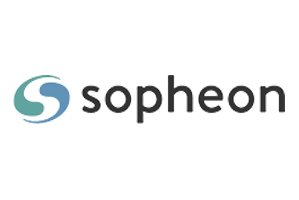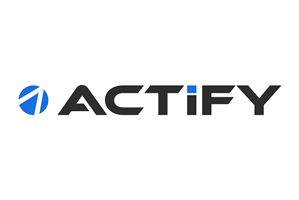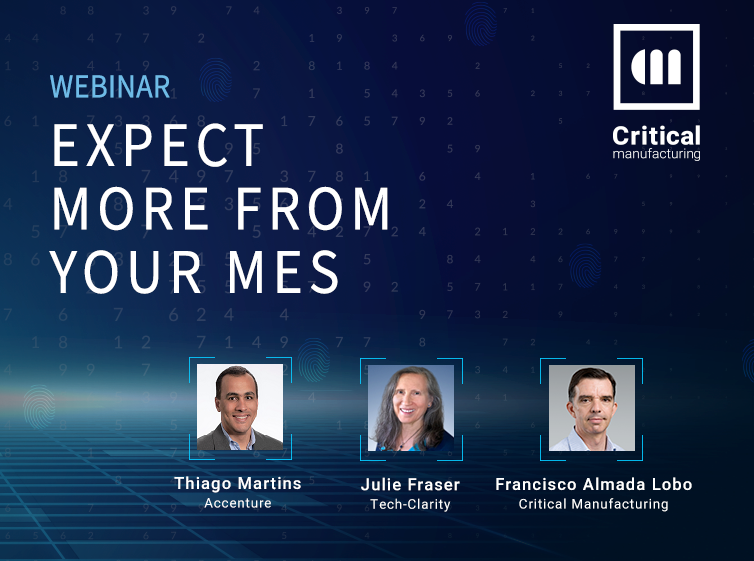Jim Brown, Michelle Boucher, and I got an introduction to Canvas GFX and its Envision product for interactive work instructions in a recent briefing. The question I, as the manufacturing analyst had, was: Can a system for model-based interactive work instructions really be easy enough for non-engineering users to embrace? Canvas GFX says yes, and…
- Manufacturing process instructions
- SOPs
- Technical documentation or manuals
- employee training
- MRO or field service repair guides
 [post_title] => Canvas Envision Takes Work Instructions to New Levels of Ease (Insight)
[post_excerpt] =>
[post_status] => publish
[comment_status] => open
[ping_status] => open
[post_password] =>
[post_name] => work-instructions-canvas-insight
[to_ping] =>
[pinged] =>
[post_modified] => 2023-05-13 14:17:32
[post_modified_gmt] => 2023-05-13 18:17:32
[post_content_filtered] =>
[post_parent] => 0
[guid] => https://tech-clarity.com/?p=18248
[menu_order] => 0
[post_type] => post
[post_mime_type] =>
[comment_count] => 0
[filter] => raw
)
[1] => WP_Post Object
(
[ID] => 18236
[post_author] => 2
[post_date] => 2023-05-10 13:42:30
[post_date_gmt] => 2023-05-10 17:42:30
[post_content] => We’ve been talking about operationalizing innovation for some time. It’s a crucial need because, as our research shows, innovation for products and services is among the top factors driving long-term business success. It can’t be left to organic inspiration or luck. It must be targeted and driven to provide a repeatable, scalable market advantage that drives profitable growth.
But what does it take to operationalize innovation? After a recent call with Sopheon, I’m happy to see there is effort being put into this question. Sopheon is supporting an initiative to define and support “InnovationOps” to serve the same role as DevOps, SecurityOps, or other approaches to take innovation to the next level. Unlike most software companies, they aren’t taking a “not invented here” approach. Instead, they are pulling together leaders in innovation practice and theory to help further the concept.
I suspect they will use what they learn to help drive their product strategy, which as I’ve written previously, has been extended to cover a broader set of processes than their traditional portfolio management solution alone. It’s a win-win, and an exciting idea that should provide a strong framework for companies to improve innovation value, speed, and efficiency.
Thank you Greg Coticchia, Mike Bauer, and Paul Heller for sharing the concept with me and inviting me to participate in the roundtables.
[post_title] => Canvas Envision Takes Work Instructions to New Levels of Ease (Insight)
[post_excerpt] =>
[post_status] => publish
[comment_status] => open
[ping_status] => open
[post_password] =>
[post_name] => work-instructions-canvas-insight
[to_ping] =>
[pinged] =>
[post_modified] => 2023-05-13 14:17:32
[post_modified_gmt] => 2023-05-13 18:17:32
[post_content_filtered] =>
[post_parent] => 0
[guid] => https://tech-clarity.com/?p=18248
[menu_order] => 0
[post_type] => post
[post_mime_type] =>
[comment_count] => 0
[filter] => raw
)
[1] => WP_Post Object
(
[ID] => 18236
[post_author] => 2
[post_date] => 2023-05-10 13:42:30
[post_date_gmt] => 2023-05-10 17:42:30
[post_content] => We’ve been talking about operationalizing innovation for some time. It’s a crucial need because, as our research shows, innovation for products and services is among the top factors driving long-term business success. It can’t be left to organic inspiration or luck. It must be targeted and driven to provide a repeatable, scalable market advantage that drives profitable growth.
But what does it take to operationalize innovation? After a recent call with Sopheon, I’m happy to see there is effort being put into this question. Sopheon is supporting an initiative to define and support “InnovationOps” to serve the same role as DevOps, SecurityOps, or other approaches to take innovation to the next level. Unlike most software companies, they aren’t taking a “not invented here” approach. Instead, they are pulling together leaders in innovation practice and theory to help further the concept.
I suspect they will use what they learn to help drive their product strategy, which as I’ve written previously, has been extended to cover a broader set of processes than their traditional portfolio management solution alone. It’s a win-win, and an exciting idea that should provide a strong framework for companies to improve innovation value, speed, and efficiency.
Thank you Greg Coticchia, Mike Bauer, and Paul Heller for sharing the concept with me and inviting me to participate in the roundtables.
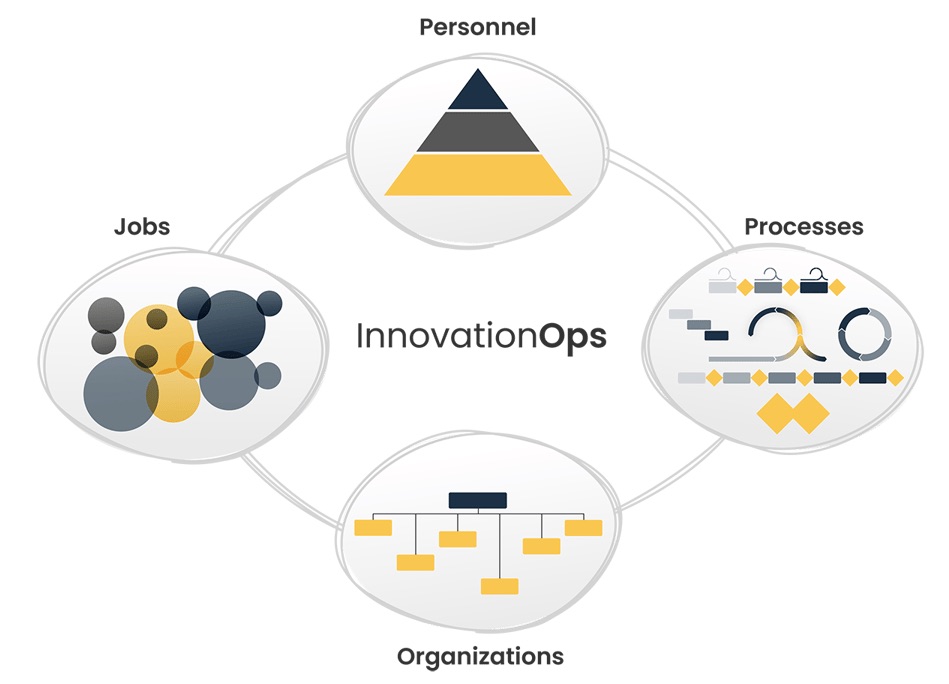 [post_title] => Sopheon Champions new InnovationOps Movement
[post_excerpt] =>
[post_status] => publish
[comment_status] => open
[ping_status] => open
[post_password] =>
[post_name] => innovationops-insight
[to_ping] =>
[pinged] =>
[post_modified] => 2023-10-24 10:38:29
[post_modified_gmt] => 2023-10-24 14:38:29
[post_content_filtered] =>
[post_parent] => 0
[guid] => https://tech-clarity.com/?p=18236
[menu_order] => 0
[post_type] => post
[post_mime_type] =>
[comment_count] => 0
[filter] => raw
)
[2] => WP_Post Object
(
[ID] => 18227
[post_author] => 2574
[post_date] => 2023-05-02 09:53:38
[post_date_gmt] => 2023-05-02 13:53:38
[post_content] => Jim Brown and I are jazzed up after learning about how Elisa IndustrIQ is combining the data management and analytics of the parent telco to strengthen already successful manufacturing applications. This combination of data structures, analytics algorithms for AI and ML, and applications that serve specific industries’ needs can deliver very high value. Elisa IndustrIQ is making its modular solution available in a way that also leverages data from outside the suite to make it even more valuable and broadly applicable.
A true digital transformation changes or extends the business model, and Finnish telco Elisa has done just that. It recognized that its analytics and automation to run the telco could apply to optimizing manufacturing. They also realized that embedding this into applications that solve real business issues would boost the customer’s value. So, for the past few years, it has been building and acquiring manufacturing applications to address manufacturing challenges, including production speed, connected supply chain, skilled workforce, climate change, and cybersecurity.
Their research showed that increased agility in production would be paramount to manufacturers’ success. Acquisitions have fueled the depth of the company’s applications and geographic spread of manufacturing-savvy people and customers:
[post_title] => Sopheon Champions new InnovationOps Movement
[post_excerpt] =>
[post_status] => publish
[comment_status] => open
[ping_status] => open
[post_password] =>
[post_name] => innovationops-insight
[to_ping] =>
[pinged] =>
[post_modified] => 2023-10-24 10:38:29
[post_modified_gmt] => 2023-10-24 14:38:29
[post_content_filtered] =>
[post_parent] => 0
[guid] => https://tech-clarity.com/?p=18236
[menu_order] => 0
[post_type] => post
[post_mime_type] =>
[comment_count] => 0
[filter] => raw
)
[2] => WP_Post Object
(
[ID] => 18227
[post_author] => 2574
[post_date] => 2023-05-02 09:53:38
[post_date_gmt] => 2023-05-02 13:53:38
[post_content] => Jim Brown and I are jazzed up after learning about how Elisa IndustrIQ is combining the data management and analytics of the parent telco to strengthen already successful manufacturing applications. This combination of data structures, analytics algorithms for AI and ML, and applications that serve specific industries’ needs can deliver very high value. Elisa IndustrIQ is making its modular solution available in a way that also leverages data from outside the suite to make it even more valuable and broadly applicable.
A true digital transformation changes or extends the business model, and Finnish telco Elisa has done just that. It recognized that its analytics and automation to run the telco could apply to optimizing manufacturing. They also realized that embedding this into applications that solve real business issues would boost the customer’s value. So, for the past few years, it has been building and acquiring manufacturing applications to address manufacturing challenges, including production speed, connected supply chain, skilled workforce, climate change, and cybersecurity.
Their research showed that increased agility in production would be paramount to manufacturers’ success. Acquisitions have fueled the depth of the company’s applications and geographic spread of manufacturing-savvy people and customers:
- CalcuQuote: Purchasing automation software for electronics manufacturing service companies or contract manufacturers based in Dallas, TX, USA
- camLine: MES and advanced SPC-based quality for semiconductor and high tech industries that originated in Germany
- TenForce: Environmental health and safety (EH&S) software company out of Belgium that is strong in chemicals
- sedApta: Supply chain planning, execution, and intelligence solutions with strength in food and beverage and customers in process, batch, and discrete industries out of Italy has Elisa as a minority owner
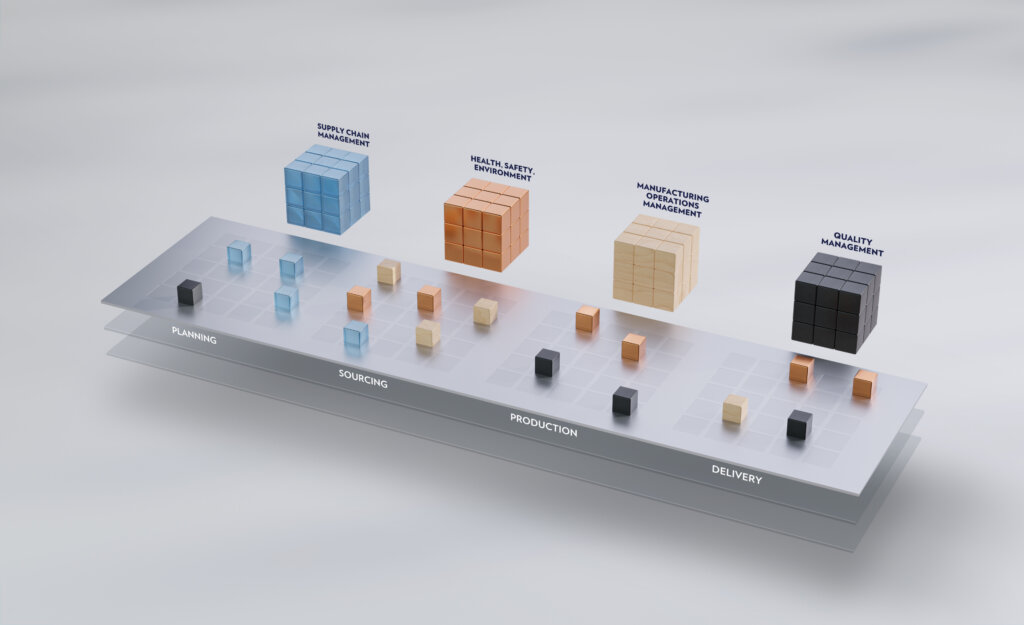 [post_title] => Elisa IndustrIQ Combines Advanced Analytics into Established Applications (Insight)
[post_excerpt] =>
[post_status] => publish
[comment_status] => open
[ping_status] => open
[post_password] =>
[post_name] => elisa-industriq-ai-modular-applications
[to_ping] =>
[pinged] =>
[post_modified] => 2023-05-06 09:55:01
[post_modified_gmt] => 2023-05-06 13:55:01
[post_content_filtered] =>
[post_parent] => 0
[guid] => https://tech-clarity.com/?p=18227
[menu_order] => 0
[post_type] => post
[post_mime_type] =>
[comment_count] => 0
[filter] => raw
)
[3] => WP_Post Object
(
[ID] => 18218
[post_author] => 2
[post_date] => 2023-04-28 09:00:07
[post_date_gmt] => 2023-04-28 13:00:07
[post_content] => It’s exciting when you see a company reinvent themselves to take on an important, unsolved problem in the industry. That’s exactly what Actify has done. We’ve been following them from the time of their early, very successful CAD viewer product line SpinFire through their new evolution to create a holistic solution for automotive project management. What they’ve done opens up a new era of solutions for program managers working for automotive suppliers, and likely for other industries to follow.
I can hear people saying “there are already lots of project management tools on the market.” True. There are also lots of PLM solutions to manage data, cloud storage solutions to manage files, and collaboration solutions to manage…well…collaboration. But automotive program management needs all of those things, and all but the biggest companies have trouble implementing and integrating all of those capabilities. What Actify has done is build a solution that is tailor-made for program managers. It not only manages documents and collaboration - it manages these in the context of an automotive program. During the demonstration, we noted how the tasks maintain the context of the program, for example a DFMEA, so managing the schedule and the work to be done are joined in one place to avoid the need for program managers to manually connect status, schedules, and work objects.
Top tier automotive suppliers live and die by their OEM relationships and the profitability of their programs. To support this, program management has evolved as a unique and critical discipline. Actify has even coined a new phrase, “Make to Program,” that reflects the unique manufacturing style and processes they support in the automotive supply chain. It’s nice to see someone developing tools that are built to work specifically for them. Especially at a time with so many new programs and the dramatic change as the automotive industry electrifies.
Thank you Peter West, Bob Anson, and Charisse Dalton for spending time and sharing the progress toward your vision with me, Julie, and Michelle.
[post_title] => Elisa IndustrIQ Combines Advanced Analytics into Established Applications (Insight)
[post_excerpt] =>
[post_status] => publish
[comment_status] => open
[ping_status] => open
[post_password] =>
[post_name] => elisa-industriq-ai-modular-applications
[to_ping] =>
[pinged] =>
[post_modified] => 2023-05-06 09:55:01
[post_modified_gmt] => 2023-05-06 13:55:01
[post_content_filtered] =>
[post_parent] => 0
[guid] => https://tech-clarity.com/?p=18227
[menu_order] => 0
[post_type] => post
[post_mime_type] =>
[comment_count] => 0
[filter] => raw
)
[3] => WP_Post Object
(
[ID] => 18218
[post_author] => 2
[post_date] => 2023-04-28 09:00:07
[post_date_gmt] => 2023-04-28 13:00:07
[post_content] => It’s exciting when you see a company reinvent themselves to take on an important, unsolved problem in the industry. That’s exactly what Actify has done. We’ve been following them from the time of their early, very successful CAD viewer product line SpinFire through their new evolution to create a holistic solution for automotive project management. What they’ve done opens up a new era of solutions for program managers working for automotive suppliers, and likely for other industries to follow.
I can hear people saying “there are already lots of project management tools on the market.” True. There are also lots of PLM solutions to manage data, cloud storage solutions to manage files, and collaboration solutions to manage…well…collaboration. But automotive program management needs all of those things, and all but the biggest companies have trouble implementing and integrating all of those capabilities. What Actify has done is build a solution that is tailor-made for program managers. It not only manages documents and collaboration - it manages these in the context of an automotive program. During the demonstration, we noted how the tasks maintain the context of the program, for example a DFMEA, so managing the schedule and the work to be done are joined in one place to avoid the need for program managers to manually connect status, schedules, and work objects.
Top tier automotive suppliers live and die by their OEM relationships and the profitability of their programs. To support this, program management has evolved as a unique and critical discipline. Actify has even coined a new phrase, “Make to Program,” that reflects the unique manufacturing style and processes they support in the automotive supply chain. It’s nice to see someone developing tools that are built to work specifically for them. Especially at a time with so many new programs and the dramatic change as the automotive industry electrifies.
Thank you Peter West, Bob Anson, and Charisse Dalton for spending time and sharing the progress toward your vision with me, Julie, and Michelle.
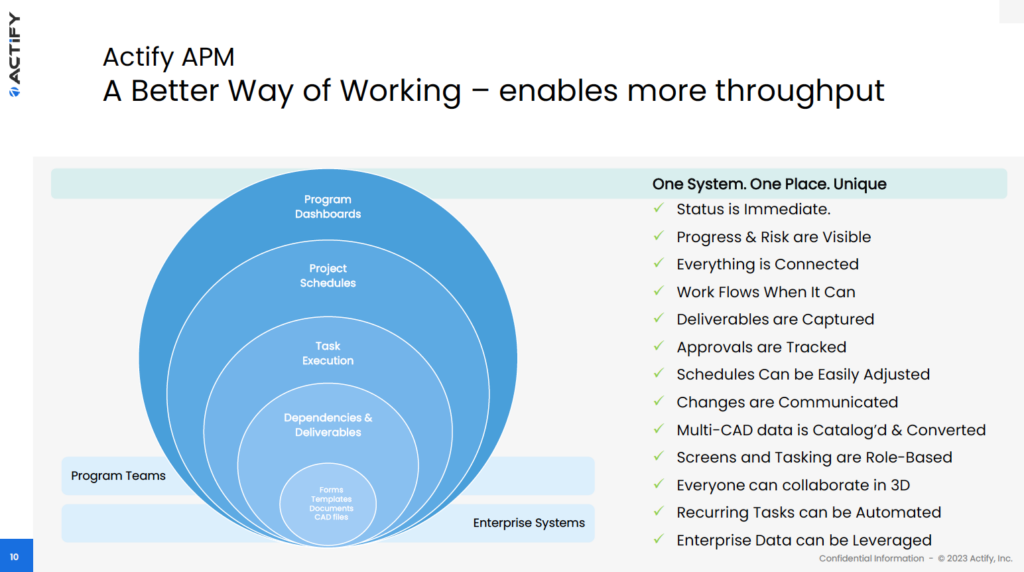 [post_title] => Actify Offers Program Management Solution for Automotive Suppliers (insight)
[post_excerpt] =>
[post_status] => publish
[comment_status] => open
[ping_status] => open
[post_password] =>
[post_name] => actify-program-management
[to_ping] =>
[pinged] =>
[post_modified] => 2023-12-14 14:54:10
[post_modified_gmt] => 2023-12-14 19:54:10
[post_content_filtered] =>
[post_parent] => 0
[guid] => https://tech-clarity.com/?p=18218
[menu_order] => 0
[post_type] => post
[post_mime_type] =>
[comment_count] => 0
[filter] => raw
)
[4] => WP_Post Object
(
[ID] => 18206
[post_author] => 2574
[post_date] => 2023-04-26 08:00:49
[post_date_gmt] => 2023-04-26 12:00:49
[post_content] => How can life sciences manufacturers accelerate their innovation? One way is by recognizing and creating an operational digital twin that’s connected to MES. We will discuss:
[post_title] => Actify Offers Program Management Solution for Automotive Suppliers (insight)
[post_excerpt] =>
[post_status] => publish
[comment_status] => open
[ping_status] => open
[post_password] =>
[post_name] => actify-program-management
[to_ping] =>
[pinged] =>
[post_modified] => 2023-12-14 14:54:10
[post_modified_gmt] => 2023-12-14 19:54:10
[post_content_filtered] =>
[post_parent] => 0
[guid] => https://tech-clarity.com/?p=18218
[menu_order] => 0
[post_type] => post
[post_mime_type] =>
[comment_count] => 0
[filter] => raw
)
[4] => WP_Post Object
(
[ID] => 18206
[post_author] => 2574
[post_date] => 2023-04-26 08:00:49
[post_date_gmt] => 2023-04-26 12:00:49
[post_content] => How can life sciences manufacturers accelerate their innovation? One way is by recognizing and creating an operational digital twin that’s connected to MES. We will discuss:
- How digital twin of operations and MES support rapid innovation while ensuring high-quality, compliant, and cost-effective operations
- Why manufacturing matters through the lifecycle of life sciences products starting in R&D and clinical trials
- How digital twin and MES support the data-driven Quality by Design (QbD) approach regulators demand
- Benefits of recognizing issues earlier in the cycle
- Specific benefits of virtual and real views that stay in sync
 For related research, read our Accelerate Life Sciences Innovation with Operations Digital Twin eBook.
[post_title] => Accelerate Manufacturing and Time to Market in Life Sciences
[post_excerpt] =>
[post_status] => publish
[comment_status] => open
[ping_status] => open
[post_password] =>
[post_name] => accelerate-manufacturing-webinar
[to_ping] =>
[pinged] =>
[post_modified] => 2024-01-02 12:01:02
[post_modified_gmt] => 2024-01-02 17:01:02
[post_content_filtered] =>
[post_parent] => 0
[guid] => https://tech-clarity.com/?p=18206
[menu_order] => 0
[post_type] => post
[post_mime_type] =>
[comment_count] => 0
[filter] => raw
)
[5] => WP_Post Object
(
[ID] => 18187
[post_author] => 2
[post_date] => 2023-04-25 10:00:25
[post_date_gmt] => 2023-04-25 14:00:25
[post_content] =>
For related research, read our Accelerate Life Sciences Innovation with Operations Digital Twin eBook.
[post_title] => Accelerate Manufacturing and Time to Market in Life Sciences
[post_excerpt] =>
[post_status] => publish
[comment_status] => open
[ping_status] => open
[post_password] =>
[post_name] => accelerate-manufacturing-webinar
[to_ping] =>
[pinged] =>
[post_modified] => 2024-01-02 12:01:02
[post_modified_gmt] => 2024-01-02 17:01:02
[post_content_filtered] =>
[post_parent] => 0
[guid] => https://tech-clarity.com/?p=18206
[menu_order] => 0
[post_type] => post
[post_mime_type] =>
[comment_count] => 0
[filter] => raw
)
[5] => WP_Post Object
(
[ID] => 18187
[post_author] => 2
[post_date] => 2023-04-25 10:00:25
[post_date_gmt] => 2023-04-25 14:00:25
[post_content] => 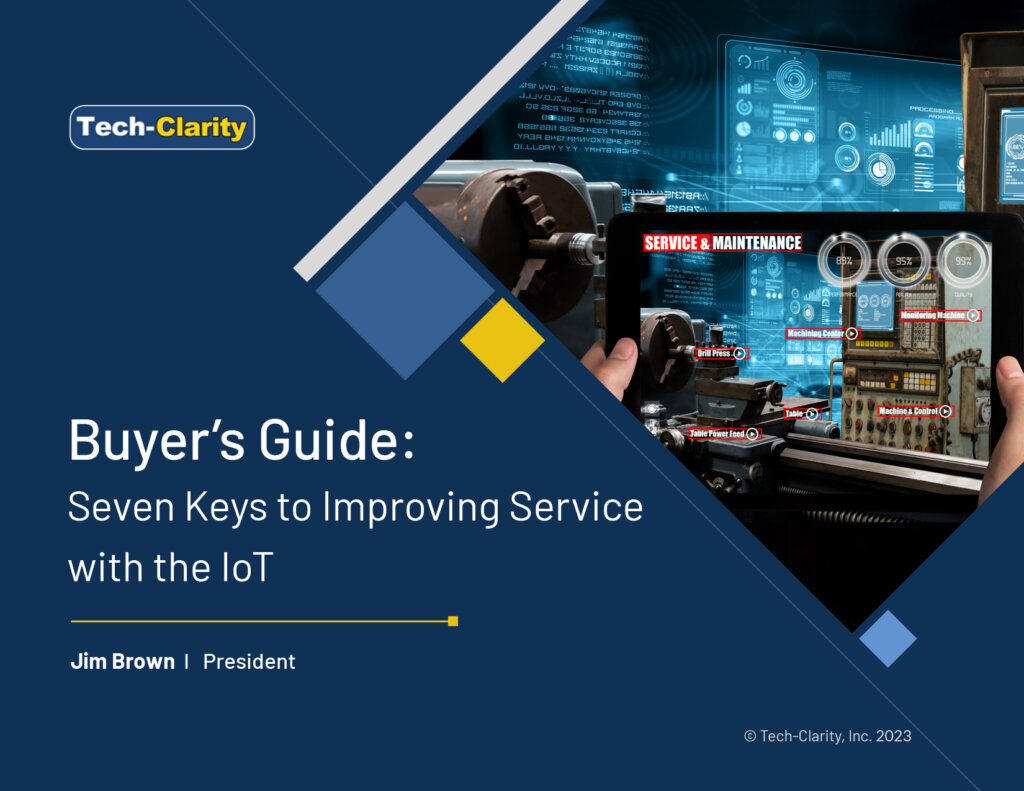 Current economic conditions make service profitability and asset longevity more important than ever. How can service organizations leverage the IoT to transform service and improve service performance and profitability? This Buyer’s Guide offers seven ways that can help companies get started or expand on early efforts, apply lessons learned from initial projects, and drive repeatable value that they can grow over time.
Please enjoy the summary* below. For the full buyer’s guide please visit our sponsor, PTC (registration required).
For related research, view our Improve Service with Equipment Monitoring infographic.
Current economic conditions make service profitability and asset longevity more important than ever. How can service organizations leverage the IoT to transform service and improve service performance and profitability? This Buyer’s Guide offers seven ways that can help companies get started or expand on early efforts, apply lessons learned from initial projects, and drive repeatable value that they can grow over time.
Please enjoy the summary* below. For the full buyer’s guide please visit our sponsor, PTC (registration required).
For related research, view our Improve Service with Equipment Monitoring infographic.
Table of Contents
- Improving Service Profitability with Condition Monitoring
- Begin the Condition Based Monitoring Journey
- Set Your Business Targets
- Access Equipment and Equipment Data
- Communicate with Equipment
- Transform Data to Increase Value
- Analyze Data to Create Service Intelligence
- Share Actionable Service Information
- Implementation and Adoption
- Selecting a Strategic Partner
- Next Steps
- Buyer's Guide Checklist
- Acknowledgments
Condition Based Monitoring Drives Improvements
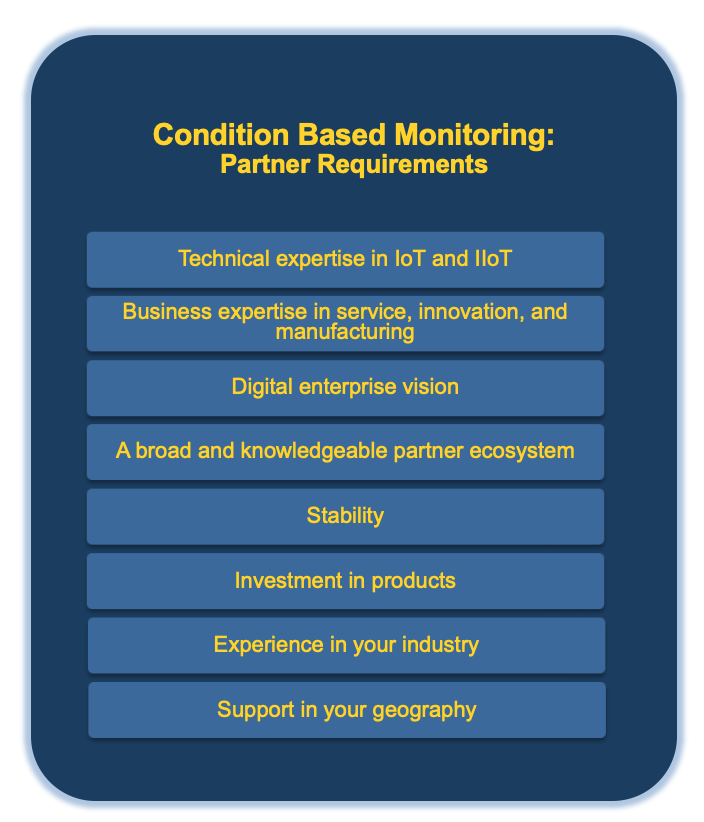 IoT Condition Based Monitoring Opportunities
Monitoring machines using the IoT offers significant business value including increased quality, manufacturing throughput, and service performance. Of these opportunities, transforming service has become a proven way to improve equipment performance and profitability in the field and in the factory.
Service transformation is a good target because service organizations have increased their maturity in the last decade and are now more sophisticated and data-driven. In addition, IoT platforms are now available to ensure companies get beyond a “proof of concept” to improve performance and profitability at scale. And as Dr. Yuri Hovanski, Associate Professor of Mechanical Engineering at Brigham Young University (BYU), explains, “Companies have been using predictive maintenance for decades. It’s not new, but the cost to deploy it 20 years ago was phenomenally expensive.” The barriers to adopt these platforms continue to drop as solution providers offer more configurable, predefined applications that are faster and less expensive to implement.
IoT Condition Based Monitoring Opportunities
Monitoring machines using the IoT offers significant business value including increased quality, manufacturing throughput, and service performance. Of these opportunities, transforming service has become a proven way to improve equipment performance and profitability in the field and in the factory.
Service transformation is a good target because service organizations have increased their maturity in the last decade and are now more sophisticated and data-driven. In addition, IoT platforms are now available to ensure companies get beyond a “proof of concept” to improve performance and profitability at scale. And as Dr. Yuri Hovanski, Associate Professor of Mechanical Engineering at Brigham Young University (BYU), explains, “Companies have been using predictive maintenance for decades. It’s not new, but the cost to deploy it 20 years ago was phenomenally expensive.” The barriers to adopt these platforms continue to drop as solution providers offer more configurable, predefined applications that are faster and less expensive to implement.
Improving Service Profitability with Condition Monitoring
Service is a Proven Value Driver The most common way that companies gain tangible performance gains from IoT is through improved service. The IoT lets companies transform service to generate more – and more profitable – service revenue. They do this by moving from reactive to proactive to predictive service. Service is an excellent opportunity to leverage advanced technologies like AI, machine learning, and big data analytics. The most common first step is reducing the cost of service through remote, condition based monitoring and is within reach for most companies. In addition, companies can improve performance through new service delivery processes like remote service. Use this Guide to Achieve Results This guide shares the tangible, practical steps companies can take to improve service through IoT condition based monitoring, how IoT platforms help deliver value, and how they can increase benefits with increased maturity. Then, the buyer’s guide focuses on the essential needs companies must consider to ensure a successful initiative. The requirements are intended to help companies frame their search process and efficiently find the right solution. The checklists go beyond software functionality to cover factors important to implementation, adoption, partner choice, and more. These are the factors that drive long-term business success from an IoT initiative.Begin the Condition Based Monitoring Journey
Start with the Basics Before looking at requirements, it’s critical to understand that improving service profitability is a journey. Condition based monitoring value starts with the basics of connecting equipment and collecting data. The first step in many companies’ journey is simply accessing equipment to understand its current location and status. Then, they can expand their benefits by gathering more complete machine data feeds to analyze performance metrics. “We learned you can’t just magically get to predictivity. You have to grow data maturity from descriptive to predictive to prescriptive. But you can get far more value from asset monitoring right away than you thought possible just based on alerts for above or below thresholds,” shares Todd Earls, VP IT for Digital Design and Manufacturing at Eaton. Grow Maturity over Time Expanding on the basics, companies can adopt advanced analytics to gain service intelligence to improve service operations by moving through increasing maturity levels. For example, one tangible objective is to recognize that there’s a problem before the customer or operator does. The key is to identify an issue, or a potential issue, in time to intervene to reduce the severity and impact of the problem. Grow Beyond Issue Identification to Remote Service It’s important to get started and then continuously improve over time. Then, as companies increase their service maturity, they can extend the value by remotely servicing equipment to further increase uptime and service margins.Next Steps
Recognize the Potential Leveraging the IoT can help companies improve service for themselves and their customers by reducing cost and transitioning to proactive and predictive service. Condition based monitoring allows companies to identify and resolve issues remotely, providing faster service and increased uptime for the customer while reducing the cost of truck rolls and putting service technicians on site. It can go beyond cost savings to improve sustainability or create new revenue from paid upgrades or remotely “unlocking” enhanced capabilities via a subscription. Get Started Now, more than ever, it’s critical to get started. Challenging financial markets make service profitability and increased asset lifecycles strategic. Service transformation has gone beyond the early adopters and is now becoming necessary to compete. Companies have to avoid “paralysis through analysis” and make tangible progress. As Danny Jackson of Autoliv advises, “Done is better than perfect, start doing some things. We lost some time trying to do it perfectly, then made more progress by doing things and learning from them.” Adopt a Pragmatic Approach
Companies have to get started, but they shouldn’t try to accomplish everything at once. Instead, it’s essential to adopt an incremental approach. Companies can organize their service and machine monitoring efforts in small, manageable, incremental “sprints” that will result in broader, transformational value. Each effort should build on the prior one. Companies should create a framework as they solve the first problem, focusing on operationalizing their capabilities and building repeatable solutions.
Extend the Value
As companies become more experienced and data-centric, they can increase the maturity of their service applications and analytics. They can apply results in their own facilities to improve how they service smart products at customer locations. They can extend to other use cases such as customer self-service, remote maintenance, predicting yield, optimizing manufacturing processes, predicting scrap/rework, or reducing process variability. There is a lot of value available across the enterprise and the value chain in addition to improving service.
This summary is an abbreviated version of the research and does not contain the full content. For the full research, please visit our sponsor PTC (registration required).
If you have difficulty obtaining a copy of the report, please contact us.
[post_title] => Seven Keys to Improving Service with the IoT
[post_excerpt] =>
[post_status] => publish
[comment_status] => open
[ping_status] => open
[post_password] =>
[post_name] => seven-keys-to-improving-service-with-the-iot-buyers-guide
[to_ping] =>
[pinged] =>
[post_modified] => 2023-12-15 15:04:08
[post_modified_gmt] => 2023-12-15 20:04:08
[post_content_filtered] =>
[post_parent] => 0
[guid] => https://tech-clarity.com/?p=18187
[menu_order] => 0
[post_type] => post
[post_mime_type] =>
[comment_count] => 0
[filter] => raw
)
[6] => WP_Post Object
(
[ID] => 18180
[post_author] => 2574
[post_date] => 2023-04-24 09:00:42
[post_date_gmt] => 2023-04-24 13:00:42
[post_content] => Are the next steps of IT/OT convergence at hand? Siemens would say yes. IT and OT are blending more than ever in some new offerings under an umbrella of data-driven manufacturing.
Siemens just announced the expansion of their Totally Integrated Automation (TIA) framework into Industrial Operations X. Industrial Operations X includes Industrial IoT, Industrial Edge, and Mendix Low-code technologies. The focus is on making it easier to integrate manufacturing IT (such as MES, HMI/SCADA) and OT (such as PLCs, DCS, and other automation). Siemens aims to deliver more flexible, interoperable, scalable, and open solutions. If they succeed, it should lower total cost of ownership (TCO).
Software-defined automation for speed and ease of converging IT and OT is another angle. News there includes the virtual PLC, an S7-1500 controller with no hardware to install. Another breakthrough is configuring OT with modern IT tools such as GitHub and text-based programming. Beyond bringing their products together, Siemens intends to help transform manufacturing engineering processes. With the skills shortage, this may be crucial.
They also announced that the IIoT platform MindSphere will be called Insights Hub starting this week. Insights Hub is one domain capability within Industrial Operations X. The foundation for all other Insights Hub applications is an app called Monitor. Other apps include OT such as SIMATIC Energy Manager and Manage MyMachines as well as new ones in IT such as OEE, Quality Prediction (combining asset and process data to feed a machine learning model), and Asset Health and Maintenance.
Siemens explains that this set of announcements is the beginning of a journey. Clearly, it expands the ecosystem they started with Industrial Edge. New IoT-based applications are in the works both from Siemens and from partners and customers leveraging low-code capabilities. HANNOVER MESSE is always a big time for Industry 4.0 announcements, and Siemens always has a big presence. Thank you Jon Heidorn, Raymond Kok, and Roland Melzer for delivering us a preview of these announcements. We look forward to following the continued convergence of Siemens’ automation and software offerings to enable manufacturers to accelerate their success.
Adopt a Pragmatic Approach
Companies have to get started, but they shouldn’t try to accomplish everything at once. Instead, it’s essential to adopt an incremental approach. Companies can organize their service and machine monitoring efforts in small, manageable, incremental “sprints” that will result in broader, transformational value. Each effort should build on the prior one. Companies should create a framework as they solve the first problem, focusing on operationalizing their capabilities and building repeatable solutions.
Extend the Value
As companies become more experienced and data-centric, they can increase the maturity of their service applications and analytics. They can apply results in their own facilities to improve how they service smart products at customer locations. They can extend to other use cases such as customer self-service, remote maintenance, predicting yield, optimizing manufacturing processes, predicting scrap/rework, or reducing process variability. There is a lot of value available across the enterprise and the value chain in addition to improving service.
This summary is an abbreviated version of the research and does not contain the full content. For the full research, please visit our sponsor PTC (registration required).
If you have difficulty obtaining a copy of the report, please contact us.
[post_title] => Seven Keys to Improving Service with the IoT
[post_excerpt] =>
[post_status] => publish
[comment_status] => open
[ping_status] => open
[post_password] =>
[post_name] => seven-keys-to-improving-service-with-the-iot-buyers-guide
[to_ping] =>
[pinged] =>
[post_modified] => 2023-12-15 15:04:08
[post_modified_gmt] => 2023-12-15 20:04:08
[post_content_filtered] =>
[post_parent] => 0
[guid] => https://tech-clarity.com/?p=18187
[menu_order] => 0
[post_type] => post
[post_mime_type] =>
[comment_count] => 0
[filter] => raw
)
[6] => WP_Post Object
(
[ID] => 18180
[post_author] => 2574
[post_date] => 2023-04-24 09:00:42
[post_date_gmt] => 2023-04-24 13:00:42
[post_content] => Are the next steps of IT/OT convergence at hand? Siemens would say yes. IT and OT are blending more than ever in some new offerings under an umbrella of data-driven manufacturing.
Siemens just announced the expansion of their Totally Integrated Automation (TIA) framework into Industrial Operations X. Industrial Operations X includes Industrial IoT, Industrial Edge, and Mendix Low-code technologies. The focus is on making it easier to integrate manufacturing IT (such as MES, HMI/SCADA) and OT (such as PLCs, DCS, and other automation). Siemens aims to deliver more flexible, interoperable, scalable, and open solutions. If they succeed, it should lower total cost of ownership (TCO).
Software-defined automation for speed and ease of converging IT and OT is another angle. News there includes the virtual PLC, an S7-1500 controller with no hardware to install. Another breakthrough is configuring OT with modern IT tools such as GitHub and text-based programming. Beyond bringing their products together, Siemens intends to help transform manufacturing engineering processes. With the skills shortage, this may be crucial.
They also announced that the IIoT platform MindSphere will be called Insights Hub starting this week. Insights Hub is one domain capability within Industrial Operations X. The foundation for all other Insights Hub applications is an app called Monitor. Other apps include OT such as SIMATIC Energy Manager and Manage MyMachines as well as new ones in IT such as OEE, Quality Prediction (combining asset and process data to feed a machine learning model), and Asset Health and Maintenance.
Siemens explains that this set of announcements is the beginning of a journey. Clearly, it expands the ecosystem they started with Industrial Edge. New IoT-based applications are in the works both from Siemens and from partners and customers leveraging low-code capabilities. HANNOVER MESSE is always a big time for Industry 4.0 announcements, and Siemens always has a big presence. Thank you Jon Heidorn, Raymond Kok, and Roland Melzer for delivering us a preview of these announcements. We look forward to following the continued convergence of Siemens’ automation and software offerings to enable manufacturers to accelerate their success.
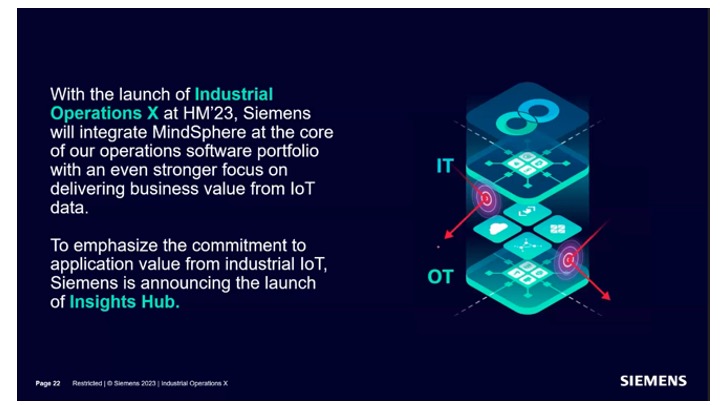 [post_title] => Siemens Advances IT/OT Convergence with Industrial Operations X (Insight)
[post_excerpt] =>
[post_status] => publish
[comment_status] => open
[ping_status] => open
[post_password] =>
[post_name] => siemens-itot-convergence-insight
[to_ping] =>
[pinged] =>
[post_modified] => 2023-04-24 23:44:30
[post_modified_gmt] => 2023-04-25 03:44:30
[post_content_filtered] =>
[post_parent] => 0
[guid] => https://tech-clarity.com/?p=18180
[menu_order] => 0
[post_type] => post
[post_mime_type] =>
[comment_count] => 0
[filter] => raw
)
[7] => WP_Post Object
(
[ID] => 18131
[post_author] => 2
[post_date] => 2023-04-12 11:00:09
[post_date_gmt] => 2023-04-12 15:00:09
[post_content] => I was recently able to catch up with Oleg Shilovitsky for an update on OpenBOM. In addition to his high blogging productivity, he and the OpenBOM team have been even harder at work developing new capabilities and expanding their reach. I’ve enjoyed following OpenBOM’s progress because they take a practical approach to solving manufacturer’s problems, started small, but built on a modern cloud stack using graph database technology so their architecture is built to scale and handle very complex problems.
They obviously help manage bills of material, one of the most challenging aspects of manufacturing definition and communication, but that’s not all. The solution has been extended to become a “digital thread platform”. OpenBOM now offers PDM features and basic capabilities for inventory, order planning, and purchasing. They’ve also continued to support more mature, complex processes by adding more data / lifecycle management features like change management, revisioning and integration with ERP. They offer an alternative, or an add-on, for smaller organizations or small groups like prototype shops in larger companies to get away from spreadsheets to manage BOMs, inventory, and orders.
As I mentioned, they’ve been hard at work. Recent enhancements allow better adoption, such as the addition of user-defined commands using a no-code approach. They have also extended onboarding training, which is included in their subscription. This is on top of embedded support in the product.
What should we look for going forward? OpenBOM will continue to support more complex scenarios including those in enterprise companies and more regulated industries. These include security enhancements to support SOC2 and offering more cloud deployment options. Lastly, they just announced a graph navigation capability that takes advantage of their core graph modeling capabilities to help companies explore their product data relationships more directly. Stay tuned for more on the opportunities that will offer.
OpenBOM is still small, but they are important. They are exploring new ways of working and filling an important need in the market. We expect to see them continue to grow and expand.
[post_title] => Siemens Advances IT/OT Convergence with Industrial Operations X (Insight)
[post_excerpt] =>
[post_status] => publish
[comment_status] => open
[ping_status] => open
[post_password] =>
[post_name] => siemens-itot-convergence-insight
[to_ping] =>
[pinged] =>
[post_modified] => 2023-04-24 23:44:30
[post_modified_gmt] => 2023-04-25 03:44:30
[post_content_filtered] =>
[post_parent] => 0
[guid] => https://tech-clarity.com/?p=18180
[menu_order] => 0
[post_type] => post
[post_mime_type] =>
[comment_count] => 0
[filter] => raw
)
[7] => WP_Post Object
(
[ID] => 18131
[post_author] => 2
[post_date] => 2023-04-12 11:00:09
[post_date_gmt] => 2023-04-12 15:00:09
[post_content] => I was recently able to catch up with Oleg Shilovitsky for an update on OpenBOM. In addition to his high blogging productivity, he and the OpenBOM team have been even harder at work developing new capabilities and expanding their reach. I’ve enjoyed following OpenBOM’s progress because they take a practical approach to solving manufacturer’s problems, started small, but built on a modern cloud stack using graph database technology so their architecture is built to scale and handle very complex problems.
They obviously help manage bills of material, one of the most challenging aspects of manufacturing definition and communication, but that’s not all. The solution has been extended to become a “digital thread platform”. OpenBOM now offers PDM features and basic capabilities for inventory, order planning, and purchasing. They’ve also continued to support more mature, complex processes by adding more data / lifecycle management features like change management, revisioning and integration with ERP. They offer an alternative, or an add-on, for smaller organizations or small groups like prototype shops in larger companies to get away from spreadsheets to manage BOMs, inventory, and orders.
As I mentioned, they’ve been hard at work. Recent enhancements allow better adoption, such as the addition of user-defined commands using a no-code approach. They have also extended onboarding training, which is included in their subscription. This is on top of embedded support in the product.
What should we look for going forward? OpenBOM will continue to support more complex scenarios including those in enterprise companies and more regulated industries. These include security enhancements to support SOC2 and offering more cloud deployment options. Lastly, they just announced a graph navigation capability that takes advantage of their core graph modeling capabilities to help companies explore their product data relationships more directly. Stay tuned for more on the opportunities that will offer.
OpenBOM is still small, but they are important. They are exploring new ways of working and filling an important need in the market. We expect to see them continue to grow and expand.
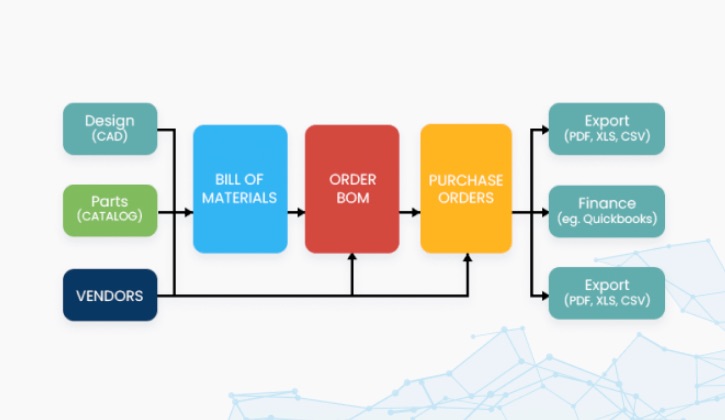 [post_title] => OpenBOM becomes a Digital Thread Platform (Insight)
[post_excerpt] =>
[post_status] => publish
[comment_status] => open
[ping_status] => open
[post_password] =>
[post_name] => openbom-digital-thread
[to_ping] =>
[pinged] =>
[post_modified] => 2023-04-12 12:10:05
[post_modified_gmt] => 2023-04-12 16:10:05
[post_content_filtered] =>
[post_parent] => 0
[guid] => https://tech-clarity.com/?p=18131
[menu_order] => 0
[post_type] => post
[post_mime_type] =>
[comment_count] => 0
[filter] => raw
)
[8] => WP_Post Object
(
[ID] => 18101
[post_author] => 2574
[post_date] => 2023-04-12 09:00:31
[post_date_gmt] => 2023-04-12 13:00:31
[post_content] =>
[post_title] => OpenBOM becomes a Digital Thread Platform (Insight)
[post_excerpt] =>
[post_status] => publish
[comment_status] => open
[ping_status] => open
[post_password] =>
[post_name] => openbom-digital-thread
[to_ping] =>
[pinged] =>
[post_modified] => 2023-04-12 12:10:05
[post_modified_gmt] => 2023-04-12 16:10:05
[post_content_filtered] =>
[post_parent] => 0
[guid] => https://tech-clarity.com/?p=18131
[menu_order] => 0
[post_type] => post
[post_mime_type] =>
[comment_count] => 0
[filter] => raw
)
[8] => WP_Post Object
(
[ID] => 18101
[post_author] => 2574
[post_date] => 2023-04-12 09:00:31
[post_date_gmt] => 2023-04-12 13:00:31
[post_content] =>  What are realistic expectations for a manufacturing execution system (MES)? Should you expect more from MES? MES has been available for decades. That is good news and bad news. Those with experience of older systems – and even many MES offered today – may have a limited view of what such a system can do. Today’s MES is an enterprise system that can drive business success in many dimensions.
You will hear from Thiago Martins, Managing Director at Accenture and Francisco Alameda Lobo, CEO at Critical Manufacturing working with MES daily as Tech-Clarity’s Julie Fraser talks to them about:
What are realistic expectations for a manufacturing execution system (MES)? Should you expect more from MES? MES has been available for decades. That is good news and bad news. Those with experience of older systems – and even many MES offered today – may have a limited view of what such a system can do. Today’s MES is an enterprise system that can drive business success in many dimensions.
You will hear from Thiago Martins, Managing Director at Accenture and Francisco Alameda Lobo, CEO at Critical Manufacturing working with MES daily as Tech-Clarity’s Julie Fraser talks to them about:
- Pre-publication highlights of a new survey on AI for Decision-Making in Manufacturing including the use and perception of MES.
- How MES can support a manufacturer in winning new customers, new contracts, and staying a preferred vendor.
- How technologies such as the industrial internet of things (IIoT), artificial intelligence (AI), and digital twins can enhance MES.
- What MES can offer to streamline frontline work for experienced and new employees.
- What is required for MES to keep up with ever-changing products and order mix.
- How integrated adaptive scheduling can improve OEE, on-time delivery, and cycle times to boost your standing as a supplier.
- The role of Low-Code and DevOps technologies in enterprise rollout and ongoing MES success.
- How much progress manufacturers are making on the many aspects of IT and OT data management required to use and analyze production data effectively.
 How can manufacturing software accelerate life sciences innovation? By combining MES with an operations digital twin.
Please enjoy the summary* below. For the full research, please visit our sponsor Dassault Systemes(registration required).
How can manufacturing software accelerate life sciences innovation? By combining MES with an operations digital twin.
Please enjoy the summary* below. For the full research, please visit our sponsor Dassault Systemes(registration required).
Table of Contents
- Rapid Life Sciences Innovation
- New Realities and Opportunities
- Manufacturing Must Keep Pace
- Digital Twins: Marrying Virtual and Real
- Operations Digital Twin Examples
- Digital Twin of Operations Accelerates Progress
- Twin Benefits in Operations
- Virtual Uses through Validation
- Virtual Uses Post-Approval
- Benefits of Virtual to and from Real
- Closing the Virtual-to-Real Loop
- Considerations for Useful Virtual
- Enterprise Transformation
- Clearing the Way for Acceleration
- Recommendations
- Acknowledgments
Rapid Life Sciences Innovation
Speed to Market Innovation has always been at the heart of life sciences companies’ success. Being quick to market helps both profits and patients. Of course, fast is relative, with most drugs and biologics taking 10-15 years from Phase I to approval, and medical devices taking three to seven years from concept to approval. The question is: Can life sciences companies accelerate this innovation process and make it more reliable? We have seen that they can by using current software and methods. It’s important to remember that innovation and supporting software serve not only R&D but also operations. Quality by Design Every aspect of innovation must increasingly aim for Quality by Design (QbD). For drugs, the EMA website defines it: “Quality by design is an approach that aims to ensure the quality of medicines by employing statistical, analytical and risk-management methodology in the design, development, and manufacturing of medicines.” Modeling and simulation allow a virtual test of a design against quality and regulatory requirements. This can result in improved product quality and patient safety before physical prototypes are built. In short, ensuring data-driven approaches early on can generate better outcomes at every stage of the product lifecycle. The chart below shows that concept. Figure 1. Accelerating Innovation Has Profits Benefits Throughout the Life Sciences Lifecycle
Recommendations
Recommendations and Next Steps Based on this research and our experience, we recommend that Life Sciences companies in biologics, pharmaceuticals, or medical devices:- Treat this as a transformational operations innovation acceleration initiative, not an IT project.
- Educate and create a vision everyone shares for a more agile manufacturing operation that accelerates innovation.
- Distinguish operations twinning from a Metaverse or gaming approach: it is for running the business, not training or purely visual representation.
- Carefully review your options to ensure the digital twin platform will support the organization now and in the future.
- Get started with twinning high-impact areas and build on the success to get maximum value and momentum.
- If you don’t have enterprise-capable manufacturing planning, scheduling, S&OP, and execution software, be sure those investments are in the plan.
- Be sure the top executive team sponsors and fully resources the program – including dedicating some of your best people and incenting everyone.
- Set an expectation that the twin will become a crucial aspect of daily operations: you will see what happens as things change and conduct what-ifs to gain speed and confidence in decisions.
- Keep the end in mind: virtual and real, constantly driving quality, innovation, improvement, and speed.
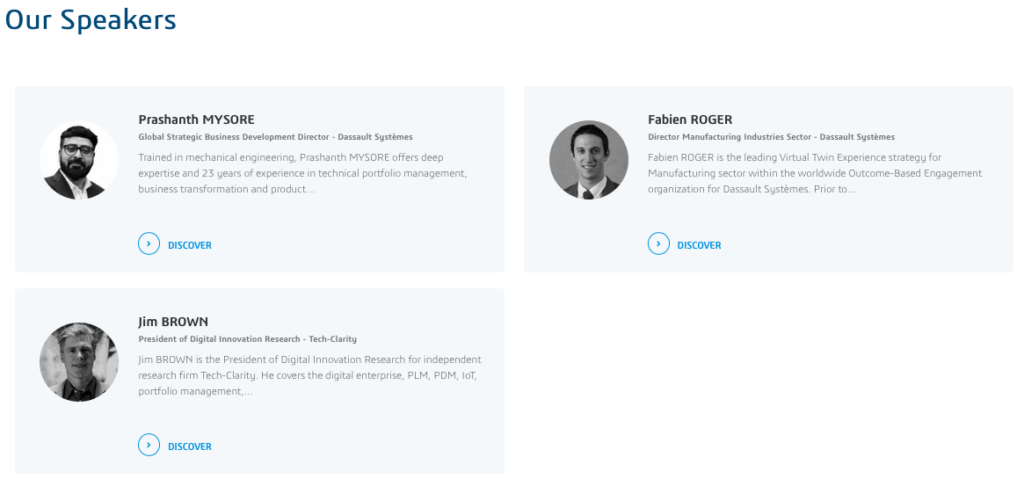 [post_title] => Is the Digital Twin Attainable?
[post_excerpt] =>
[post_status] => publish
[comment_status] => open
[ping_status] => open
[post_password] =>
[post_name] => digital-twin-attainability-webinar
[to_ping] =>
[pinged] =>
[post_modified] => 2023-12-15 15:04:50
[post_modified_gmt] => 2023-12-15 20:04:50
[post_content_filtered] =>
[post_parent] => 0
[guid] => https://tech-clarity.com/?p=18042
[menu_order] => 0
[post_type] => post
[post_mime_type] =>
[comment_count] => 0
[filter] => raw
)
[11] => WP_Post Object
(
[ID] => 18059
[post_author] => 2
[post_date] => 2023-04-05 08:00:44
[post_date_gmt] => 2023-04-05 12:00:44
[post_content] =>
[post_title] => Is the Digital Twin Attainable?
[post_excerpt] =>
[post_status] => publish
[comment_status] => open
[ping_status] => open
[post_password] =>
[post_name] => digital-twin-attainability-webinar
[to_ping] =>
[pinged] =>
[post_modified] => 2023-12-15 15:04:50
[post_modified_gmt] => 2023-12-15 20:04:50
[post_content_filtered] =>
[post_parent] => 0
[guid] => https://tech-clarity.com/?p=18042
[menu_order] => 0
[post_type] => post
[post_mime_type] =>
[comment_count] => 0
[filter] => raw
)
[11] => WP_Post Object
(
[ID] => 18059
[post_author] => 2
[post_date] => 2023-04-05 08:00:44
[post_date_gmt] => 2023-04-05 12:00:44
[post_content] => 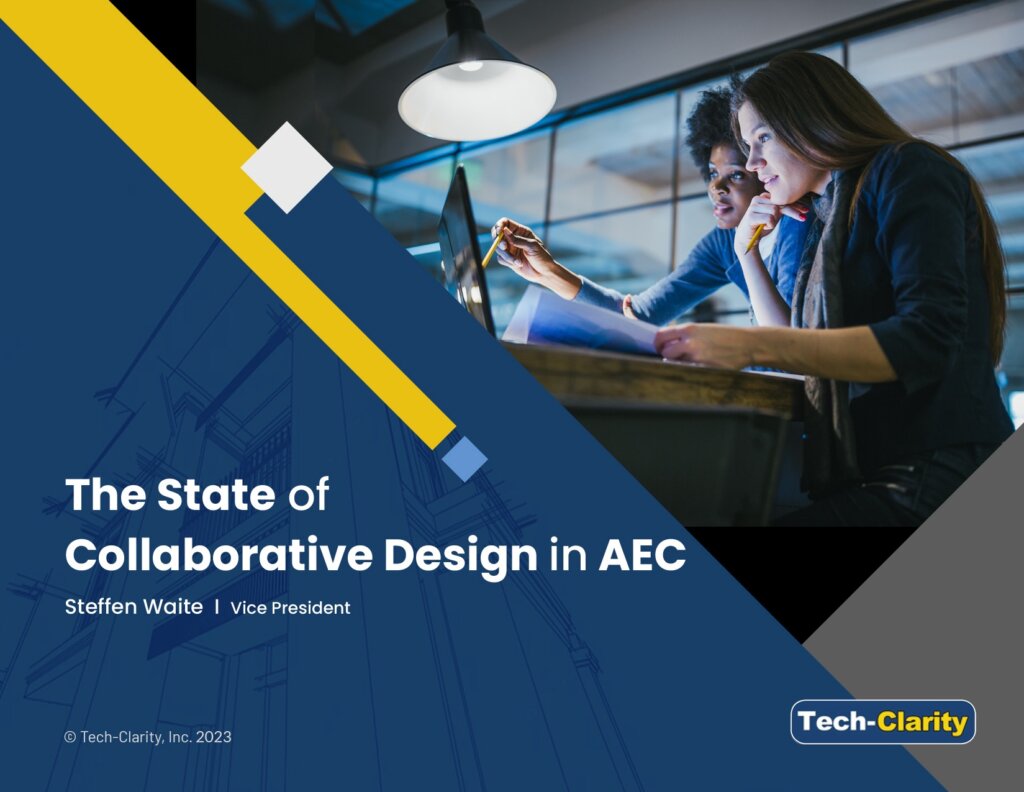 How well is collaboration working in the AEC industry? We surveyed 393 people whose companies design, engineer, or construct the built environment to find out about collaborative design in AEC, including multidisciplinary design and BIM.
Please enjoy the summary* below. For the full research, please visit our sponsor Graphisoft (registration required).
How well is collaboration working in the AEC industry? We surveyed 393 people whose companies design, engineer, or construct the built environment to find out about collaborative design in AEC, including multidisciplinary design and BIM.
Please enjoy the summary* below. For the full research, please visit our sponsor Graphisoft (registration required).
Table of Contents
- Profitability Demands Compelling Yet Efficient Design
- Communication and Complexity are Top Challenges
- Design Complexity is Growing
- Complexity Requires Multidisciplinary Collaboration
- Current Collaboration Has Room to Improve
- Importance of Design Integration
- Integration Approaches are Insufficient
- BIM as a Solution for Design Integration
- BIM is Maturing to Become the System of Record
- Importance of Design Integration Approaches
- Companies are Adopting Multidisciplinary Design
- Multidisciplinary Design Provides Valuable Benefits
- Perspectives on Multidisciplinary Design
- Multidisciplinary Design Faces Challenges
- Challenges Lead to Business Impacts
- Value of a Single BIM Authoring Environment
- Views on a Single BIM Authoring Environment
- IPD is Growing and Requires Multidisciplinary Design
- Fear of Trading off Capabilities
- Conclusions
- About the Research
- Acknowledgments
Executive Summary
Collaboration Design in AEC Our survey investigated the current state of collaboration and multidisciplinary design in the AEC community. The research focused on current approaches to collaboration, the readiness to adopt advanced design tools, and how these factors impact project success and profitability. The study focused primarily on the design and design coordination phase of the full built-project lifecycle and does not significantly include the experience of the construction community. About three-quarters (72%) of the research respondents are architects and the vast majority of companies offer architectural and/or engineering services. The study shows that architects must design concepts with strong aesthetics and build their company reputation while also recognizing the need to meet practical project objectives like project cost and schedule. Unfortunately, poor communication and increased design complexity, which emerged as two of the most common challenges to meeting project objectives and outcomes, make this difficult. Beyond this, almost two-thirds of survey respondents report that design complexity has increased over the last five years.
Insufficient Collaboration and Design Integration Approaches
Designers recognize that working collaboratively across disciplines helps manage increased design complexity. However, the most common forms of collaboration include email, in-person meetings, PDFs, and hard-copy sheets. These methods are inefficient and error-prone. In addition, despite the fact that about two-thirds of respondents report that design integration across disciplines is critical or important to project success, the design integration approaches they typically use, like collecting 2D or printed documents, are also insufficient.
The study shows that architects must design concepts with strong aesthetics and build their company reputation while also recognizing the need to meet practical project objectives like project cost and schedule. Unfortunately, poor communication and increased design complexity, which emerged as two of the most common challenges to meeting project objectives and outcomes, make this difficult. Beyond this, almost two-thirds of survey respondents report that design complexity has increased over the last five years.
Insufficient Collaboration and Design Integration Approaches
Designers recognize that working collaboratively across disciplines helps manage increased design complexity. However, the most common forms of collaboration include email, in-person meetings, PDFs, and hard-copy sheets. These methods are inefficient and error-prone. In addition, despite the fact that about two-thirds of respondents report that design integration across disciplines is critical or important to project success, the design integration approaches they typically use, like collecting 2D or printed documents, are also insufficient.
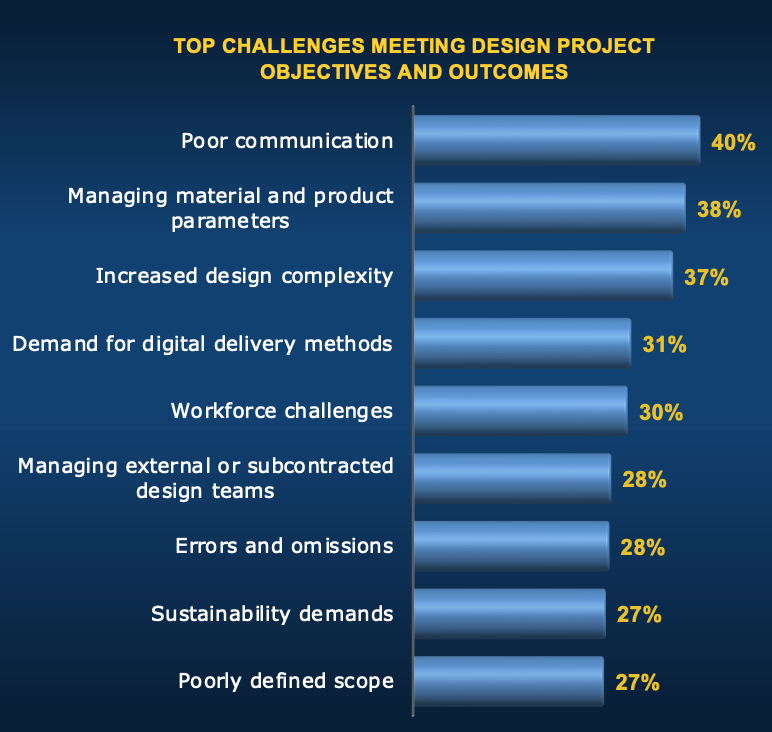 The Multidisciplinary Design Opportunity
Although the AEC industry faces increased complexity, the design and construction community has been hesitant to adopt new technologies and integrated data platforms. Our research shows, however, that surveyed companies are exploring and migrating to multidisciplinary design to drive efficiency, improve project outcomes, and reduce cost (among other drivers).
Multidisciplinary design marries the efforts of different disciplines into a cohesive process. This increases efficiency and provides impact visibility to designers. They can assess the impacts of choices on a design's cost, more efficiently deal with clashes and geometric constraints, and better tackle complexity driven by code upgrades, material improvements, and energy performance.
The Multidisciplinary Design Transition
The study finds that full multidisciplinary design adoption is still relatively low in the architecture and engineering community, with only 22% of respondents using it on all projects. But about two-thirds of respondents have a positive perception of this methodology, and over one-half of companies are using it on at least some projects.
Although there are barriers to adoption, including organizational, technical, and business concerns, companies report valuable benefits. Over two-thirds of companies who have adopted multidisciplinary design for all projects report more complete designs and fewer errors and omissions. About one-half report increased efficiency and improved constructability. The opportunities are compelling and available. The eBook shares the full details of our findings.
The Multidisciplinary Design Opportunity
Although the AEC industry faces increased complexity, the design and construction community has been hesitant to adopt new technologies and integrated data platforms. Our research shows, however, that surveyed companies are exploring and migrating to multidisciplinary design to drive efficiency, improve project outcomes, and reduce cost (among other drivers).
Multidisciplinary design marries the efforts of different disciplines into a cohesive process. This increases efficiency and provides impact visibility to designers. They can assess the impacts of choices on a design's cost, more efficiently deal with clashes and geometric constraints, and better tackle complexity driven by code upgrades, material improvements, and energy performance.
The Multidisciplinary Design Transition
The study finds that full multidisciplinary design adoption is still relatively low in the architecture and engineering community, with only 22% of respondents using it on all projects. But about two-thirds of respondents have a positive perception of this methodology, and over one-half of companies are using it on at least some projects.
Although there are barriers to adoption, including organizational, technical, and business concerns, companies report valuable benefits. Over two-thirds of companies who have adopted multidisciplinary design for all projects report more complete designs and fewer errors and omissions. About one-half report increased efficiency and improved constructability. The opportunities are compelling and available. The eBook shares the full details of our findings.
Conclusions
Communication is the Biggest Challenge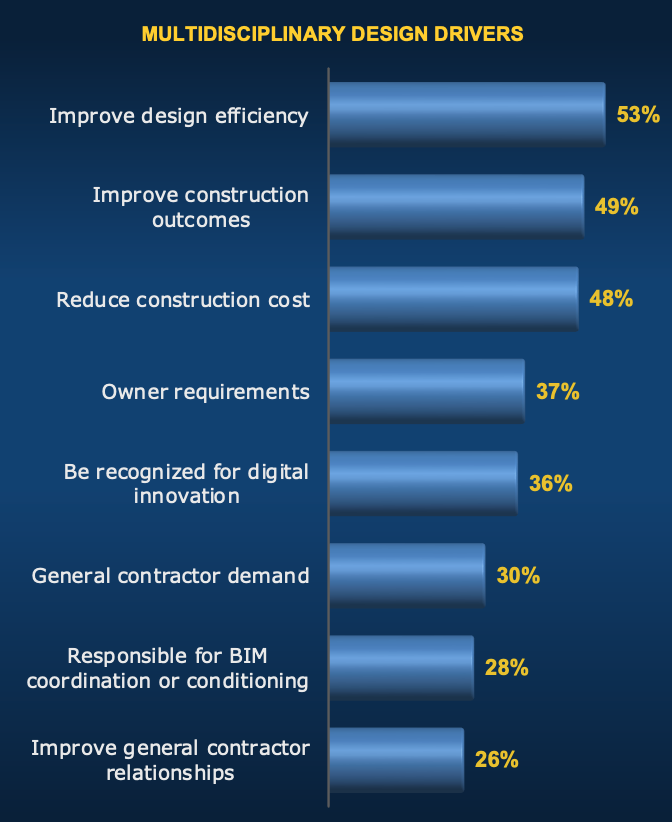 The design and construction industry is highly fragmented. Companies range in size and the cross-section of industry segments they serve. Project
participants often span regional, country, language, and cultural boundaries. Multiple disciplines rarely share common offices, which only exacerbates the challenge of communication. With increasing project complexity and shrinking access to well-trained resources, communication is strained. The industry must uncover ways to become more effective.
Greater Collaboration is the Key
Architecture and engineering companies must increase their ability to effectively collaborate across design disciplines. Traditional collaboration approaches are insufficient. Fortunately, there are proven benefits to digitally integrating designs across disciplines. Typical integration methods must also improve, and the data demonstrates that the AEC design community is moving towards more enhanced collaboration workflows leveraging tools based on BIM. The role of BIM is also maturing to be a system of record. Although the domains of design are vast, our research concludes that companies are exploring and migrating to multidisciplinary design to drive better project outcomes and profitability.
Multidisciplinary Design Remains Novel in the Maturity Cycle
Full multidisciplinary design adoption is still relatively low, but those adopting it are achieving significant benefits. The overall perception of multidisciplinary design and BIM is positive, yet it faces a number of challenges. Most companies are not willing to trade off significant design functionality for those benefits. We expect to see greater adoption of multidisciplinary design as systems mature, but also expect that companies must maintain an open approach to BIM tools to accommodate an environment consisting of multiple authoring tools.
*This summary is an abbreviated version of the research and does not contain the full content. For the full research, please visit our sponsor Graphisoft (registration required).
If you have difficulty obtaining a copy of the report, please contact us.
[post_title] => The State of Collaborative Design in AEC
[post_excerpt] =>
[post_status] => publish
[comment_status] => open
[ping_status] => open
[post_password] =>
[post_name] => collaborative-design-in-aec
[to_ping] =>
[pinged] =>
[post_modified] => 2023-12-14 16:18:24
[post_modified_gmt] => 2023-12-14 21:18:24
[post_content_filtered] =>
[post_parent] => 0
[guid] => https://tech-clarity.com/?p=18059
[menu_order] => 0
[post_type] => post
[post_mime_type] =>
[comment_count] => 0
[filter] => raw
)
[12] => WP_Post Object
(
[ID] => 18011
[post_author] => 2
[post_date] => 2023-03-27 10:00:38
[post_date_gmt] => 2023-03-27 14:00:38
[post_content] => We spoke with Hexagon following a recent event launching their Nexus platform. Hexagon already offers a wide range of solutions supporting the product lifecycle, including design and engineering; production; and metrology and inspection portfolios from its Manufacturing Intelligence division and others including the newly acquired Enterprise Asset Management (EAM) and quality management (QMS, ETQ) solutions. This release gives Hexagon a platform to connect across their solutions, and solutions from others, to execute and automate workflows that cross application boundaries.
They’re taking a data-centric approach to connecting heterogeneous solutions, providing contextual data to streamline across steps in the process and create a common digital thread. Hexagon is calling Nexus a “digital reality platform.” They compare it with a digital twin. They say it’s different, though, because it is connected in near-real-time with products and machines to integrate information support automation in addition to user-driven tasks. In their words, Nexus “connects applications, hardware, and anything creating data in a democratized manner.”
An example we explored during our call was an electronics designer changing a printed circuit board in their PCB design tool that would share the relevant change with a mechanical designer in the CAD tool. In addition, they pointed out it could autonomously run a simulation in the cloud to validate the resulting change, for example heat exchange. The example helped me grasp the fact that Nexus is intended to share data directly between different applications and tools, not just pass the information to the next user in a traditional workflow. That level of data integration is highly valuable.
The platform provides central services like visualization and analytics and will be offered as Nexus Platform Services. In addition, they’re busy developing Nexus Applications on the platform, including several announced in the launch event and a roadmap of solutions in development. They will also provide partners with the ability to develop applications for Nexus and plan to create an active ecosystem of applications and services offered through Nexus. In the future, they intend to open application development to customers so they can create their own connected workflows.
Hexagon has a wealth of solutions for manufacturers, and now has a platform and strategy that will allow customers to get the most out of them in a connected, data-centric, cloud-based platform. Thank you Stephen Graham and Robin Wolstenholme for taking the time to provide more detail and answer our questions, Michelle Boucher, Julie Fraser, and I appreciated and enjoyed it.
The design and construction industry is highly fragmented. Companies range in size and the cross-section of industry segments they serve. Project
participants often span regional, country, language, and cultural boundaries. Multiple disciplines rarely share common offices, which only exacerbates the challenge of communication. With increasing project complexity and shrinking access to well-trained resources, communication is strained. The industry must uncover ways to become more effective.
Greater Collaboration is the Key
Architecture and engineering companies must increase their ability to effectively collaborate across design disciplines. Traditional collaboration approaches are insufficient. Fortunately, there are proven benefits to digitally integrating designs across disciplines. Typical integration methods must also improve, and the data demonstrates that the AEC design community is moving towards more enhanced collaboration workflows leveraging tools based on BIM. The role of BIM is also maturing to be a system of record. Although the domains of design are vast, our research concludes that companies are exploring and migrating to multidisciplinary design to drive better project outcomes and profitability.
Multidisciplinary Design Remains Novel in the Maturity Cycle
Full multidisciplinary design adoption is still relatively low, but those adopting it are achieving significant benefits. The overall perception of multidisciplinary design and BIM is positive, yet it faces a number of challenges. Most companies are not willing to trade off significant design functionality for those benefits. We expect to see greater adoption of multidisciplinary design as systems mature, but also expect that companies must maintain an open approach to BIM tools to accommodate an environment consisting of multiple authoring tools.
*This summary is an abbreviated version of the research and does not contain the full content. For the full research, please visit our sponsor Graphisoft (registration required).
If you have difficulty obtaining a copy of the report, please contact us.
[post_title] => The State of Collaborative Design in AEC
[post_excerpt] =>
[post_status] => publish
[comment_status] => open
[ping_status] => open
[post_password] =>
[post_name] => collaborative-design-in-aec
[to_ping] =>
[pinged] =>
[post_modified] => 2023-12-14 16:18:24
[post_modified_gmt] => 2023-12-14 21:18:24
[post_content_filtered] =>
[post_parent] => 0
[guid] => https://tech-clarity.com/?p=18059
[menu_order] => 0
[post_type] => post
[post_mime_type] =>
[comment_count] => 0
[filter] => raw
)
[12] => WP_Post Object
(
[ID] => 18011
[post_author] => 2
[post_date] => 2023-03-27 10:00:38
[post_date_gmt] => 2023-03-27 14:00:38
[post_content] => We spoke with Hexagon following a recent event launching their Nexus platform. Hexagon already offers a wide range of solutions supporting the product lifecycle, including design and engineering; production; and metrology and inspection portfolios from its Manufacturing Intelligence division and others including the newly acquired Enterprise Asset Management (EAM) and quality management (QMS, ETQ) solutions. This release gives Hexagon a platform to connect across their solutions, and solutions from others, to execute and automate workflows that cross application boundaries.
They’re taking a data-centric approach to connecting heterogeneous solutions, providing contextual data to streamline across steps in the process and create a common digital thread. Hexagon is calling Nexus a “digital reality platform.” They compare it with a digital twin. They say it’s different, though, because it is connected in near-real-time with products and machines to integrate information support automation in addition to user-driven tasks. In their words, Nexus “connects applications, hardware, and anything creating data in a democratized manner.”
An example we explored during our call was an electronics designer changing a printed circuit board in their PCB design tool that would share the relevant change with a mechanical designer in the CAD tool. In addition, they pointed out it could autonomously run a simulation in the cloud to validate the resulting change, for example heat exchange. The example helped me grasp the fact that Nexus is intended to share data directly between different applications and tools, not just pass the information to the next user in a traditional workflow. That level of data integration is highly valuable.
The platform provides central services like visualization and analytics and will be offered as Nexus Platform Services. In addition, they’re busy developing Nexus Applications on the platform, including several announced in the launch event and a roadmap of solutions in development. They will also provide partners with the ability to develop applications for Nexus and plan to create an active ecosystem of applications and services offered through Nexus. In the future, they intend to open application development to customers so they can create their own connected workflows.
Hexagon has a wealth of solutions for manufacturers, and now has a platform and strategy that will allow customers to get the most out of them in a connected, data-centric, cloud-based platform. Thank you Stephen Graham and Robin Wolstenholme for taking the time to provide more detail and answer our questions, Michelle Boucher, Julie Fraser, and I appreciated and enjoyed it.
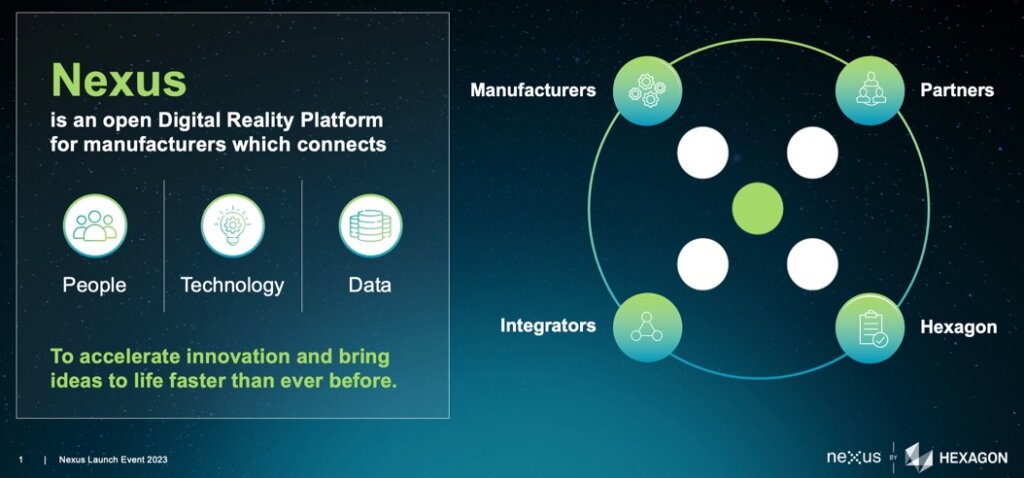 [post_title] => Hexagon Launches Digital Reality Platform, Nexus (Insight)
[post_excerpt] =>
[post_status] => publish
[comment_status] => open
[ping_status] => open
[post_password] =>
[post_name] => digital-reality-platform-hexagon-insight
[to_ping] =>
[pinged] =>
[post_modified] => 2023-03-27 14:15:51
[post_modified_gmt] => 2023-03-27 18:15:51
[post_content_filtered] =>
[post_parent] => 0
[guid] => https://tech-clarity.com/?p=18011
[menu_order] => 0
[post_type] => post
[post_mime_type] =>
[comment_count] => 0
[filter] => raw
)
[13] => WP_Post Object
(
[ID] => 18019
[post_author] => 2574
[post_date] => 2023-03-24 09:30:46
[post_date_gmt] => 2023-03-24 13:30:46
[post_content] => What are some keys to success with Industry 4.0? And what does mindfulness have to do with it? Listen to this fireside chat with Julie Fraser, hosted by the Industry 4.0 Club’s Mike Ungar and Mike Yost to start thinking about your ecosystem for success.
An ecosystem is the environment in which a variety of compatible organisms - or organizations - coexist. Some elements go together and some do not. For Industry 4.0, each player must review fit and ability to support each other over a longer period of time. Rather than thinking of vendors and customers, moving to view each other as partners is a start.
What does that entail? How can manufacturers identify partners that will truly partner and support them? What can the solution providers do to bolster their customer-partners’ success?
In this video, you’ll get to hear what Julie and the two Mikes think and have seen. You’ll also hear about a trend that’s beyond the “talking about” stage and into the “take action” stage this year. Industry 4.0 technologies will support this earth-level ecosystem issue. Julie also takes some questions from the LinkedIn Live audience.
Thank you, Industry 4.0 Club, for the opportunity to have a conversation on all of this!
[post_title] => Hexagon Launches Digital Reality Platform, Nexus (Insight)
[post_excerpt] =>
[post_status] => publish
[comment_status] => open
[ping_status] => open
[post_password] =>
[post_name] => digital-reality-platform-hexagon-insight
[to_ping] =>
[pinged] =>
[post_modified] => 2023-03-27 14:15:51
[post_modified_gmt] => 2023-03-27 18:15:51
[post_content_filtered] =>
[post_parent] => 0
[guid] => https://tech-clarity.com/?p=18011
[menu_order] => 0
[post_type] => post
[post_mime_type] =>
[comment_count] => 0
[filter] => raw
)
[13] => WP_Post Object
(
[ID] => 18019
[post_author] => 2574
[post_date] => 2023-03-24 09:30:46
[post_date_gmt] => 2023-03-24 13:30:46
[post_content] => What are some keys to success with Industry 4.0? And what does mindfulness have to do with it? Listen to this fireside chat with Julie Fraser, hosted by the Industry 4.0 Club’s Mike Ungar and Mike Yost to start thinking about your ecosystem for success.
An ecosystem is the environment in which a variety of compatible organisms - or organizations - coexist. Some elements go together and some do not. For Industry 4.0, each player must review fit and ability to support each other over a longer period of time. Rather than thinking of vendors and customers, moving to view each other as partners is a start.
What does that entail? How can manufacturers identify partners that will truly partner and support them? What can the solution providers do to bolster their customer-partners’ success?
In this video, you’ll get to hear what Julie and the two Mikes think and have seen. You’ll also hear about a trend that’s beyond the “talking about” stage and into the “take action” stage this year. Industry 4.0 technologies will support this earth-level ecosystem issue. Julie also takes some questions from the LinkedIn Live audience.
Thank you, Industry 4.0 Club, for the opportunity to have a conversation on all of this!
 [post_title] => An Ecosystem Enabling Manufacturers and Industry 4.0 Providers to Flourish with Julie Fraser
[post_excerpt] =>
[post_status] => publish
[comment_status] => open
[ping_status] => open
[post_password] =>
[post_name] => ecosystem-for-industry-4-0
[to_ping] =>
[pinged] =>
[post_modified] => 2023-03-28 14:12:15
[post_modified_gmt] => 2023-03-28 18:12:15
[post_content_filtered] =>
[post_parent] => 0
[guid] => https://tech-clarity.com/?p=18019
[menu_order] => 0
[post_type] => post
[post_mime_type] =>
[comment_count] => 0
[filter] => raw
)
[14] => WP_Post Object
(
[ID] => 18001
[post_author] => 2574
[post_date] => 2023-03-21 09:30:11
[post_date_gmt] => 2023-03-21 13:30:11
[post_content] => I recently got an update briefing from iTAC Software AG, which was eye-opening. It appears you can now get deep out-of-the-box MES/MOM functionality plus low-code ways to extend the software. This company has offered #MES for many years but has recently expanded on many fronts.
The original company philosophy of bidirectional integration with equipment has served iTAC well in its core discrete industry segments. That’s been strengthened by adding Cogiscan to the iTAC group. Customers have advanced in their ability to be agile and respond to change also, as the group also includes DUALIS GmbH IT Solution advanced planning and scheduling.
Some of the newer functionality is compelling.
[post_title] => An Ecosystem Enabling Manufacturers and Industry 4.0 Providers to Flourish with Julie Fraser
[post_excerpt] =>
[post_status] => publish
[comment_status] => open
[ping_status] => open
[post_password] =>
[post_name] => ecosystem-for-industry-4-0
[to_ping] =>
[pinged] =>
[post_modified] => 2023-03-28 14:12:15
[post_modified_gmt] => 2023-03-28 18:12:15
[post_content_filtered] =>
[post_parent] => 0
[guid] => https://tech-clarity.com/?p=18019
[menu_order] => 0
[post_type] => post
[post_mime_type] =>
[comment_count] => 0
[filter] => raw
)
[14] => WP_Post Object
(
[ID] => 18001
[post_author] => 2574
[post_date] => 2023-03-21 09:30:11
[post_date_gmt] => 2023-03-21 13:30:11
[post_content] => I recently got an update briefing from iTAC Software AG, which was eye-opening. It appears you can now get deep out-of-the-box MES/MOM functionality plus low-code ways to extend the software. This company has offered #MES for many years but has recently expanded on many fronts.
The original company philosophy of bidirectional integration with equipment has served iTAC well in its core discrete industry segments. That’s been strengthened by adding Cogiscan to the iTAC group. Customers have advanced in their ability to be agile and respond to change also, as the group also includes DUALIS GmbH IT Solution advanced planning and scheduling.
Some of the newer functionality is compelling.
- Plant floor logistics with two-way communication to AGVs and AIVs is much-needed in the increasingly automated plant floors iTAC serves.
- Data analytics are designed to work with iTAC’s #IIoT or other IoT platforms. The IIoT.Edge and SMT. Edge products offer AI-based analytics at the edge using algorithms iTAC offers but are also open for customers to develop or use their own algorithms.
 [post_title] => iTAC MES/MOM Adds Low-Code, Logistics, and Edge Analytics (Insight)
[post_excerpt] =>
[post_status] => publish
[comment_status] => open
[ping_status] => open
[post_password] =>
[post_name] => itac-mes-insight
[to_ping] =>
[pinged] =>
[post_modified] => 2023-03-24 14:03:49
[post_modified_gmt] => 2023-03-24 18:03:49
[post_content_filtered] =>
[post_parent] => 0
[guid] => https://tech-clarity.com/?p=18001
[menu_order] => 0
[post_type] => post
[post_mime_type] =>
[comment_count] => 0
[filter] => raw
)
[15] => WP_Post Object
(
[ID] => 17975
[post_author] => 2
[post_date] => 2023-03-16 09:00:55
[post_date_gmt] => 2023-03-16 13:00:55
[post_content] =>
[post_title] => iTAC MES/MOM Adds Low-Code, Logistics, and Edge Analytics (Insight)
[post_excerpt] =>
[post_status] => publish
[comment_status] => open
[ping_status] => open
[post_password] =>
[post_name] => itac-mes-insight
[to_ping] =>
[pinged] =>
[post_modified] => 2023-03-24 14:03:49
[post_modified_gmt] => 2023-03-24 18:03:49
[post_content_filtered] =>
[post_parent] => 0
[guid] => https://tech-clarity.com/?p=18001
[menu_order] => 0
[post_type] => post
[post_mime_type] =>
[comment_count] => 0
[filter] => raw
)
[15] => WP_Post Object
(
[ID] => 17975
[post_author] => 2
[post_date] => 2023-03-16 09:00:55
[post_date_gmt] => 2023-03-16 13:00:55
[post_content] =>  How can high tech manufacturers improve manufacturing engineering? We surveyed 177 people directly involved with manufacturing engineering and found that modernizing processes and technology drives higher manufacturing engineering productivity and performance. These improvements are crucial to profitability as customers demand high quality, personalized products at increasingly faster time to market; all despite rising product and manufacturing complexity.
Unfortunately, high tech companies face challenges in process design as products, manufacturing processes, including:
How can high tech manufacturers improve manufacturing engineering? We surveyed 177 people directly involved with manufacturing engineering and found that modernizing processes and technology drives higher manufacturing engineering productivity and performance. These improvements are crucial to profitability as customers demand high quality, personalized products at increasingly faster time to market; all despite rising product and manufacturing complexity.
Unfortunately, high tech companies face challenges in process design as products, manufacturing processes, including:
- Visibility to manufacturing capabilities
- Untimely design data
- Visualizing assembly processes
- Predicting impacts on sustainability
Table of Contents
- Improve Manufacturing Engineering to Increase Profitability
- Address Process Designer Challenges
- Recognize the Opportunity
- Quantify the Potential
- Identify Performance Drivers
- Find Issues Earlier in Design
- Use more 3D and Simulation
- Leverage More Integrated Solutions
- Use More Advanced Communication and Collaboration
- Top Performers Show the Way
- Recommendations and Next Steps
- About the Research
- Acknowledgments
Improve Manufacturing Engineering Performance
Improve Performance in the Face of Complexity How can high tech manufacturers improve manufacturing engineering? We surveyed 177 people directly involved with manufacturing engineering and found that modernizing processes and technology drives higher manufacturing engineering productivity and performance. These improvements are crucial to profitability as customers demand high quality, more personalized products at increasingly faster time to market; all despite rising product and manufacturing complexity. Modernize Manufacturing Engineering Survey results show that Top Performers (see definition in eBook) in manufacturing engineering have increased maturity in the way they plan, validate, and communicate manufacturing operations. These leading companies waste less time on non-value-added activities, find issues sooner, and spend less on physical prototypes. They accomplish this through best practices, including:- More advanced collaboration and communication methods
- Increased use of 3D and simulation to plan and validate manufacturing operations with virtual, digital twins
Recognize the Opportunity
Manufacturing Engineering is Ready for an Upgrade It’s time for change. Manufacturers must digitalize production planning to reduce cycle times, increase efficiently, and deliver quality. High tech companies need to adopt new techniques to validate manufacturing earlier in the process, in parallel with product design.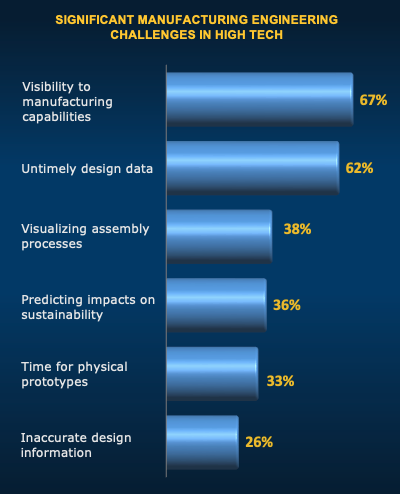 Current Processes can be Improved
There is significant room for improvement. The majority of companies validate process plans with time-consuming and expensive physical prototyping. Physical prototypes bring abstract designs into the real world so engineers can identify issues and improvement opportunities. Most companies also use spreadsheets, which are prone to errors and file-based so they are not conducive to collaboration. These approaches lead to late discoveries and expensive process validation.
Leverage Visual Approaches
Trading physical prototypes for digital validation reduces time and cost. A significant number of companies already use some form of virtual representations. Static visualizations can help engineers see an issue in the digital world before committing to a physical prototype or manufacturing equipment.
Adopt Simulation
Beyond static images, virtual simulation helps designers go beyond “seeing” to virtually experiencing the production process. While only about one-quarter use either 2D or 3D simulation, it’s a promising technology and a potential for significant planning and validation improvement.
Current Processes can be Improved
There is significant room for improvement. The majority of companies validate process plans with time-consuming and expensive physical prototyping. Physical prototypes bring abstract designs into the real world so engineers can identify issues and improvement opportunities. Most companies also use spreadsheets, which are prone to errors and file-based so they are not conducive to collaboration. These approaches lead to late discoveries and expensive process validation.
Leverage Visual Approaches
Trading physical prototypes for digital validation reduces time and cost. A significant number of companies already use some form of virtual representations. Static visualizations can help engineers see an issue in the digital world before committing to a physical prototype or manufacturing equipment.
Adopt Simulation
Beyond static images, virtual simulation helps designers go beyond “seeing” to virtually experiencing the production process. While only about one-quarter use either 2D or 3D simulation, it’s a promising technology and a potential for significant planning and validation improvement.
Recommendations and Next Steps
Make a Strategic Improvement Today’s product, manufacturing process, and market complexity demand new ways of working. The Top Performers are transforming manufacturing engineering through digitalization, better collaboration, 3D, and simulation allowing them to overcome efficiency, quality, and cost challenges. Using virtual, digital twins offers manufacturing engineers both the ability to improve their own performance and a strategic opportunity to increase overall product development profitability. These leaders spend 17% less time on non-value-added activities in manufacturing engineering, directly reducing development cycle times. Improve Time to Market Survey respondents report that they can reduce time to market by 37% by using 3D and simulation to plan and validate manufacturing operations. This is done, in part, by increasing efficiency, reducing time-consuming physical prototyping, and lowering rework by finding issues sooner in product development. This is critical in the high tech industry where time to market drives market share and products have such short lifecycles. Reduce Cost Survey respondents share that they can eliminate 36% of their prototypes by increasing manufacturing engineering maturity, leading to significant cost savings per product. They do this by shifting validation and issue identification sooner in the product development process so they need fewer physical prototypes. Increase Quality
Responding companies also indicate that they can reduce ECOs by over one-third. They do this by improving manufacturing process design using virtual technologies. Top Performers are more likely to find physical manufacturing issues in a virtual model than Others who are more likely to discover them in physical prototypes and actual production.
Get Started
It’s time to improve manufacturing engineering productivity and performance. Companies can follow the lead of the Top Performers to increase maturity in how they plan, validate, and communicate manufacturing plans. To increase maturity, manufacturers should adopt the best practices of the Top Performers, including using integrated solutions such as 3D and simulation for manufacturing engineering.
*This summary is an abbreviated version of the research and does not contain the full content. For the full research, please visit our sponsor Dassault Systèmes DELMIA (registration required).
If you have difficulty obtaining a copy of the report, please contact us.
[post_title] => Transforming High Tech Manufacturing Engineering
[post_excerpt] =>
[post_status] => publish
[comment_status] => open
[ping_status] => open
[post_password] =>
[post_name] => high-tech-ebook
[to_ping] =>
[pinged] =>
[post_modified] => 2024-01-30 13:57:06
[post_modified_gmt] => 2024-01-30 18:57:06
[post_content_filtered] =>
[post_parent] => 0
[guid] => https://tech-clarity.com/?p=17975
[menu_order] => 0
[post_type] => post
[post_mime_type] =>
[comment_count] => 0
[filter] => raw
)
[16] => WP_Post Object
(
[ID] => 17918
[post_author] => 2
[post_date] => 2023-03-14 09:00:18
[post_date_gmt] => 2023-03-14 13:00:18
[post_content] =>
Increase Quality
Responding companies also indicate that they can reduce ECOs by over one-third. They do this by improving manufacturing process design using virtual technologies. Top Performers are more likely to find physical manufacturing issues in a virtual model than Others who are more likely to discover them in physical prototypes and actual production.
Get Started
It’s time to improve manufacturing engineering productivity and performance. Companies can follow the lead of the Top Performers to increase maturity in how they plan, validate, and communicate manufacturing plans. To increase maturity, manufacturers should adopt the best practices of the Top Performers, including using integrated solutions such as 3D and simulation for manufacturing engineering.
*This summary is an abbreviated version of the research and does not contain the full content. For the full research, please visit our sponsor Dassault Systèmes DELMIA (registration required).
If you have difficulty obtaining a copy of the report, please contact us.
[post_title] => Transforming High Tech Manufacturing Engineering
[post_excerpt] =>
[post_status] => publish
[comment_status] => open
[ping_status] => open
[post_password] =>
[post_name] => high-tech-ebook
[to_ping] =>
[pinged] =>
[post_modified] => 2024-01-30 13:57:06
[post_modified_gmt] => 2024-01-30 18:57:06
[post_content_filtered] =>
[post_parent] => 0
[guid] => https://tech-clarity.com/?p=17975
[menu_order] => 0
[post_type] => post
[post_mime_type] =>
[comment_count] => 0
[filter] => raw
)
[16] => WP_Post Object
(
[ID] => 17918
[post_author] => 2
[post_date] => 2023-03-14 09:00:18
[post_date_gmt] => 2023-03-14 13:00:18
[post_content] =>  Why is effective bill of material management critical to digital transformation? What should you look for in a BOM management solution? Our white paper serves as a reference tool for manufacturers selecting a system to improve the maturity of their BOM management practices.
Please enjoy the summary* below. For the full buyer's guide please visit our sponsor, PTC (registration required).
This white paper is an update to our original buyer's guide published in 2020.
Why is effective bill of material management critical to digital transformation? What should you look for in a BOM management solution? Our white paper serves as a reference tool for manufacturers selecting a system to improve the maturity of their BOM management practices.
Please enjoy the summary* below. For the full buyer's guide please visit our sponsor, PTC (registration required).
This white paper is an update to our original buyer's guide published in 2020.
Table of Contents
- Introducing the Buyer's Guide
- Diagnosing BOM Management Issues
- The BOM Management Status Quo
- The BOM Management Business Case
- Analyze BOM Management Solution Capabilities
- Assess Service Requirements
- Consider Vendor Requirements
- Special Considerations
- Conclusions
- Recommendations
- Acknowledgments
- About the Author
Introducing the Buyer's Guide
Managing Bills of Material (BOMs) is a fundamental need for any manufacturer. Without effective control of product structures, companies struggle with inefficiency and errors. On the other hand, improving the maturity of BOM-related processes helps manage complexity, increase product personalization, improve efficiency, prevent mistakes, and enhance collaboration across departments and the supply chain. The resulting benefits can be strategic, leading to increased innovation, agility, and faster time to market that impact top-line financial performance. BOM management is now essential as the foundation for the digital enterprise and serves as the backbone of the digital twin. Effective BOM management is also critical for manufacturers to confidently change products to adapt to market challenges like chip shortages and supply chain disruption.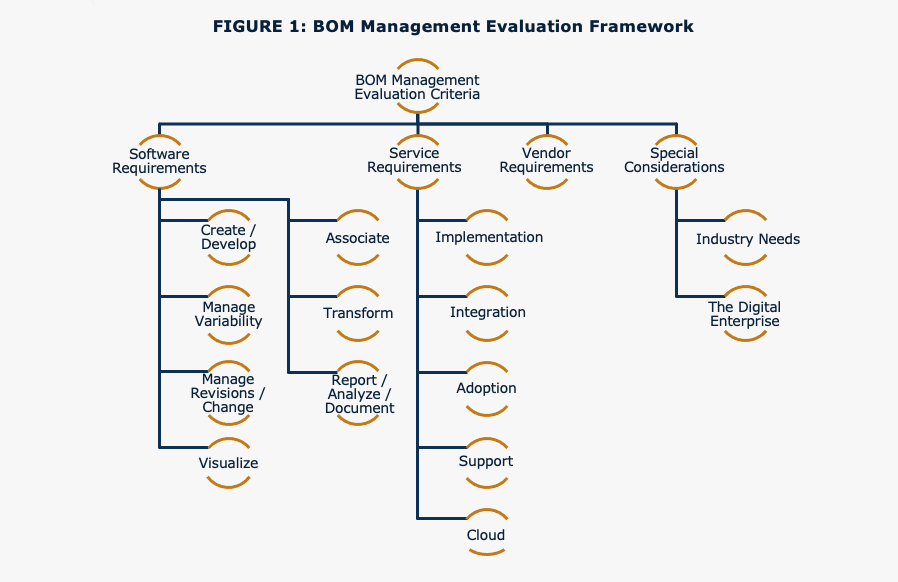 This Buyer’s Guide is a reference tool for manufacturers selecting a system to improve the maturity of their BOM management practices. The guide is composed of sections covering software, service, and vendor requirements, along with some special considerations. These are all important factors that impact implementation success and ROI.
Each of these sections includes a checklist with key requirements to investigate when selecting software to enable and improve BOM management. The guide also touches on special considerations for companies to keep an eye on by industry. It also shows how digital BOM management plays a critical role in supporting digital transformation initiatives, including the digital twin, digital thread service transformation, Industry 4.0, and more.
This Buyer’s Guide is a reference tool for manufacturers selecting a system to improve the maturity of their BOM management practices. The guide is composed of sections covering software, service, and vendor requirements, along with some special considerations. These are all important factors that impact implementation success and ROI.
Each of these sections includes a checklist with key requirements to investigate when selecting software to enable and improve BOM management. The guide also touches on special considerations for companies to keep an eye on by industry. It also shows how digital BOM management plays a critical role in supporting digital transformation initiatives, including the digital twin, digital thread service transformation, Industry 4.0, and more.
Analyzing BOM Management Solution Capabilities
Perhaps the most obvious place to start when evaluating new software solutions is functionality. This section covers multiple types and uses of product structures, including Engineering BOMs (EBOM), Manufacturing BOMs (MBOM), Service BOMs (SBOM), and others such as those used for simulation or compliance analysis. For the purposes of this analysis, we’ve broken BOM management into seven main focus areas:- Developing product structures
- Managing revisions and change
- Supporting product variability
- Associating information
- Transforming BOMs
- Visualizing products
- Reporting, analyzing, documenting
- Controlling and securing product-related data
- Quickly finding and reusing information
- Sharing product knowledge with other departments (and beyond enterprise boundaries)
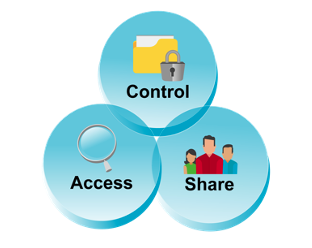 Clearly, a user should be able to enter a BOM manually from a screen by selecting a combination of materials, components, or lower-level assemblies. Systems should also be able to accept and validate an input file, for example, a spreadsheet or XML file, to import / upload BOMs from another system or in a “mass load” scenario. Finally, the system should be able to develop BOMs from underlying engineering tools for efficiency and to prevent manual transcription errors, also known as the “bottom-up” approach.
Of these, the most complex scenario is the bottoms up creation from a Computer Aided Design (CAD) tool. This scenario requires the BOM management solution to digitally interpret the contents of the CAD structure. CAD systems typically contain a lot of information about a product, making good CAD integration a primary need.
Clearly, a user should be able to enter a BOM manually from a screen by selecting a combination of materials, components, or lower-level assemblies. Systems should also be able to accept and validate an input file, for example, a spreadsheet or XML file, to import / upload BOMs from another system or in a “mass load” scenario. Finally, the system should be able to develop BOMs from underlying engineering tools for efficiency and to prevent manual transcription errors, also known as the “bottom-up” approach.
Of these, the most complex scenario is the bottoms up creation from a Computer Aided Design (CAD) tool. This scenario requires the BOM management solution to digitally interpret the contents of the CAD structure. CAD systems typically contain a lot of information about a product, making good CAD integration a primary need.
Conclusion
BOM management helps manage complexity and streamline operations. It provides an important, foundational element that serves as the backbone for all engineering, manufacturing, and service activity. An accessible, trusted source of product structure information is valuable and improves traceability and control. Effective BOM management provides enterprise-level benefits, improving business performance and alleviating disconnects across the business. The net result is efficiency and cost gains combined with revenue improvement from better collaboration and faster time to market, making BOM management an essential operational tool and a key driver of improved profitability. Supporting BOM management at the enterprise level requires the right solution. Companies should develop a requirements list that helps encourage a holistic decision encompassing software functionality, service-related needs, vendor requirements, and any special considerations based on their industry, size, and product strategy. Finally, the plan should look beyond current needs to support the digital future where the Digital Twin, Digital Thread, AR, VR, and IoT rely on sound BOM information.Recommendations
Based on industry experience and research for this report, Tech-Clarity offers the following recommendations:- Think big, but remain agile and take BOM management improvement in steps
- Recognize the importance of accurate, complete, timely, and accessible product structures
- Develop a comprehensive, multidiscipline, and multi-CAD BOM management capability
- Look for functionality, but extend requirements to vendor and service considerations
- Look for a Cloud / SaaS solution to reduce risk, ease adoption, and ensure vendor market competitiveness
- Consider any special needs for your business, industry, or geography
- Provide the foundation for the digital enterprise to compete today and into the future
- Get started
Product Updates in Onshape
David also shared an overview of some of their key product releases over the last year, including: PCB Studio: Supports concurrent ECAD and MCAD design.- Render Studio: Offers photorealistic imagery
- Onshape Simulation: Gives design engineers easy access to structural analysis during design
- Frames: Enables quick design of structural frames
- Variables Studios: Provides a way to define and modify common variables across parts and assemblies
Agile Product Development
Jon Hirschtick shared his perspective as well. He stressed that they see much interest from companies looking to apply the Agile Methodology they use for software development to hardware (see graphic below). He cited trends driving this interest include:- Product development tools have evolved
- The new generation workforce wants to work in a more agile way
- The pace of change is so significant, companies need new methodologies to allow them to quickly adapt and pivot
Simulation in Onshape
I believe their approach to simulation could also be a key enabler for Agile. With it, design engineers do not have to worry about translating or meshing their model, and the software already understands assembly constraints. Consequently, design engineers, including those unfamiliar with simulation, can apply loads and view the results. Our research consistently shows that the activities involved with preprocessing, particularly defining the mesh, are one of the biggest bottlenecks for design engineers’ use of simulation. Onshape’s approach automates much of this, making it easier to adopt. Since Onshape Simulation is cloud-based, the processing is done on the cloud, without slowing down the engineer’s workstation. Another engineer can pull up the model and make changes, and the engineers can work together to evaluate the results. With this approach, the potential for supporting the Agile Methodology during short sprints of design, prototype, and test looks very powerful. I look forward to seeing the new developments in 2023. Thanks to Coray Thibaut de Maisieres and the Onshape team for putting on a great event.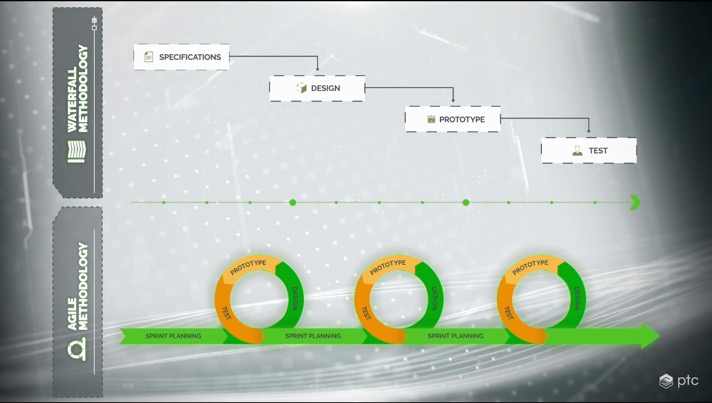 [post_title] => Onshape Live 23 Reveals Significant Progress
[post_excerpt] =>
[post_status] => publish
[comment_status] => open
[ping_status] => open
[post_password] =>
[post_name] => onshape-live-2023
[to_ping] =>
[pinged] =>
[post_modified] => 2023-12-15 12:39:02
[post_modified_gmt] => 2023-12-15 17:39:02
[post_content_filtered] =>
[post_parent] => 0
[guid] => https://tech-clarity.com/?p=17946
[menu_order] => 0
[post_type] => post
[post_mime_type] =>
[comment_count] => 0
[filter] => raw
)
[18] => WP_Post Object
(
[ID] => 17938
[post_author] => 2574
[post_date] => 2023-03-08 09:00:52
[post_date_gmt] => 2023-03-08 14:00:52
[post_content] => There is more exciting news from GE Digital on its newest Proficy MES version. In a previous discussion, we learned that all of the GE Smart Factory Portfolio are becoming available not only on-premises but also on cloud or hybrid. As a fully-hosted managed service for MES-as-a-Service, MES can always be up to date with improvements from lean or continuous improvement (CI) efforts. GE claims up to 30% lower total cost of ownership (TCO) and reduced maintenance while improving security.
The composable architecture now supports OEE, production, and quality management. With cloud hosting, smaller manufacturers can also deploy MES effectively. Another aspect of this release that supports quick results and lasting value is the dozens of out-of-the-box configured screens. These are ready to support production, quality, and performance measurement workflows in process, discrete, and mixed-mode environments.
No-code capabilities also enable customers to tailor the MES to their specific needs. This can be crucial in supporting frontline workers’ adoption of MES. The quality module also offers a way for operators to comment on issues as they arise.
All of these enhancements are to an MES that is already deep and broad. Progress toward the cloud in manufacturing software is continuing. GE offers that option for those who want it, but also on-premise and hybrid for those maintaining those environments. Thank you, Sumit Pal, for sharing this with us!
[post_title] => Onshape Live 23 Reveals Significant Progress
[post_excerpt] =>
[post_status] => publish
[comment_status] => open
[ping_status] => open
[post_password] =>
[post_name] => onshape-live-2023
[to_ping] =>
[pinged] =>
[post_modified] => 2023-12-15 12:39:02
[post_modified_gmt] => 2023-12-15 17:39:02
[post_content_filtered] =>
[post_parent] => 0
[guid] => https://tech-clarity.com/?p=17946
[menu_order] => 0
[post_type] => post
[post_mime_type] =>
[comment_count] => 0
[filter] => raw
)
[18] => WP_Post Object
(
[ID] => 17938
[post_author] => 2574
[post_date] => 2023-03-08 09:00:52
[post_date_gmt] => 2023-03-08 14:00:52
[post_content] => There is more exciting news from GE Digital on its newest Proficy MES version. In a previous discussion, we learned that all of the GE Smart Factory Portfolio are becoming available not only on-premises but also on cloud or hybrid. As a fully-hosted managed service for MES-as-a-Service, MES can always be up to date with improvements from lean or continuous improvement (CI) efforts. GE claims up to 30% lower total cost of ownership (TCO) and reduced maintenance while improving security.
The composable architecture now supports OEE, production, and quality management. With cloud hosting, smaller manufacturers can also deploy MES effectively. Another aspect of this release that supports quick results and lasting value is the dozens of out-of-the-box configured screens. These are ready to support production, quality, and performance measurement workflows in process, discrete, and mixed-mode environments.
No-code capabilities also enable customers to tailor the MES to their specific needs. This can be crucial in supporting frontline workers’ adoption of MES. The quality module also offers a way for operators to comment on issues as they arise.
All of these enhancements are to an MES that is already deep and broad. Progress toward the cloud in manufacturing software is continuing. GE offers that option for those who want it, but also on-premise and hybrid for those maintaining those environments. Thank you, Sumit Pal, for sharing this with us!
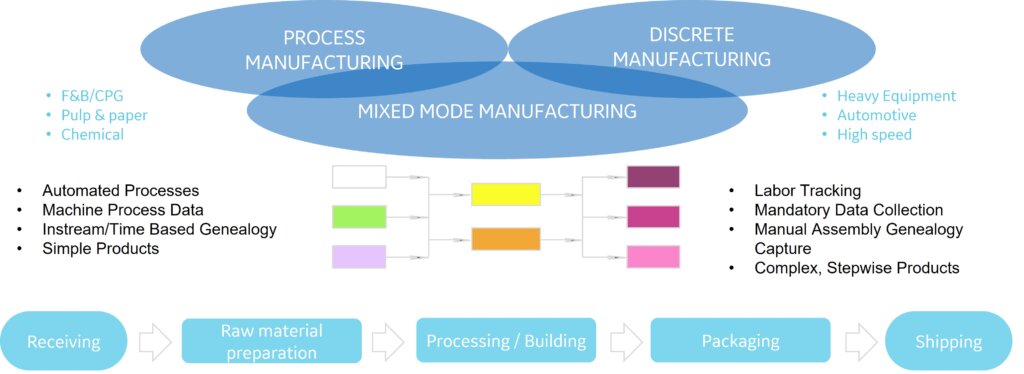
[post_title] => GE Enhances Cloud MES for TCO, Flexibility (Insight) [post_excerpt] => [post_status] => publish [comment_status] => open [ping_status] => open [post_password] => [post_name] => cloud-mes-insight [to_ping] => [pinged] => [post_modified] => 2023-03-13 15:54:34 [post_modified_gmt] => 2023-03-13 19:54:34 [post_content_filtered] => [post_parent] => 0 [guid] => https://tech-clarity.com/?p=17938 [menu_order] => 0 [post_type] => post [post_mime_type] => [comment_count] => 0 [filter] => raw ) [19] => WP_Post Object ( [ID] => 17895 [post_author] => 2 [post_date] => 2023-02-23 09:00:57 [post_date_gmt] => 2023-02-23 14:00:57 [post_content] =>
 How can manufacturers overcome their product data gaps to improve new product introduction and drive product profitability? Jim Brown joined Propel’s Converged Live webinar, The Product Information Disconnect: How Collaboration Drives Business Value and Customer Loyalty, to preview his latest research on the product information disconnect and how to solve it.
View the webinar on demand to hear Jim Brown and Propel's Mark Boles and Tom Shoemaker in this open conversation to:
How can manufacturers overcome their product data gaps to improve new product introduction and drive product profitability? Jim Brown joined Propel’s Converged Live webinar, The Product Information Disconnect: How Collaboration Drives Business Value and Customer Loyalty, to preview his latest research on the product information disconnect and how to solve it.
View the webinar on demand to hear Jim Brown and Propel's Mark Boles and Tom Shoemaker in this open conversation to:
- Learn how disconnected data and processes derail product introduction, leaving time and money on the table
- Find out how using a single digital thread delivers accurate information every time, from design to commercialization
- Discover the fastest, most accurate way to launch quality products across every channel
- Manufacturing process instructions
- SOPs
- Technical documentation or manuals
- employee training
- MRO or field service repair guides
 [post_title] => Canvas Envision Takes Work Instructions to New Levels of Ease (Insight)
[post_excerpt] =>
[post_status] => publish
[comment_status] => open
[ping_status] => open
[post_password] =>
[post_name] => work-instructions-canvas-insight
[to_ping] =>
[pinged] =>
[post_modified] => 2023-05-13 14:17:32
[post_modified_gmt] => 2023-05-13 18:17:32
[post_content_filtered] =>
[post_parent] => 0
[guid] => https://tech-clarity.com/?p=18248
[menu_order] => 0
[post_type] => post
[post_mime_type] =>
[comment_count] => 0
[filter] => raw
)
[comment_count] => 0
[current_comment] => -1
[found_posts] => 802
[max_num_pages] => 41
[max_num_comment_pages] => 0
[is_single] =>
[is_preview] =>
[is_page] =>
[is_archive] =>
[is_date] =>
[is_year] =>
[is_month] =>
[is_day] =>
[is_time] =>
[is_author] =>
[is_category] =>
[is_tag] =>
[is_tax] =>
[is_search] =>
[is_feed] =>
[is_comment_feed] =>
[is_trackback] =>
[is_home] => 1
[is_privacy_policy] =>
[is_404] =>
[is_embed] =>
[is_paged] =>
[is_admin] =>
[is_attachment] =>
[is_singular] =>
[is_robots] =>
[is_favicon] =>
[is_posts_page] =>
[is_post_type_archive] =>
[query_vars_hash:WP_Query:private] => 54594893464df1fa8bb0d2fd5f77c742
[query_vars_changed:WP_Query:private] => 1
[thumbnails_cached] =>
[allow_query_attachment_by_filename:protected] =>
[stopwords:WP_Query:private] =>
[compat_fields:WP_Query:private] => Array
(
[0] => query_vars_hash
[1] => query_vars_changed
)
[compat_methods:WP_Query:private] => Array
(
[0] => init_query_flags
[1] => parse_tax_query
)
[query_cache_key:WP_Query:private] => wp_query:6049db6e622d4a1c677063273e8c5614:0.77527400 17638371620.78434400 1763837162
)
[post_title] => Canvas Envision Takes Work Instructions to New Levels of Ease (Insight)
[post_excerpt] =>
[post_status] => publish
[comment_status] => open
[ping_status] => open
[post_password] =>
[post_name] => work-instructions-canvas-insight
[to_ping] =>
[pinged] =>
[post_modified] => 2023-05-13 14:17:32
[post_modified_gmt] => 2023-05-13 18:17:32
[post_content_filtered] =>
[post_parent] => 0
[guid] => https://tech-clarity.com/?p=18248
[menu_order] => 0
[post_type] => post
[post_mime_type] =>
[comment_count] => 0
[filter] => raw
)
[comment_count] => 0
[current_comment] => -1
[found_posts] => 802
[max_num_pages] => 41
[max_num_comment_pages] => 0
[is_single] =>
[is_preview] =>
[is_page] =>
[is_archive] =>
[is_date] =>
[is_year] =>
[is_month] =>
[is_day] =>
[is_time] =>
[is_author] =>
[is_category] =>
[is_tag] =>
[is_tax] =>
[is_search] =>
[is_feed] =>
[is_comment_feed] =>
[is_trackback] =>
[is_home] => 1
[is_privacy_policy] =>
[is_404] =>
[is_embed] =>
[is_paged] =>
[is_admin] =>
[is_attachment] =>
[is_singular] =>
[is_robots] =>
[is_favicon] =>
[is_posts_page] =>
[is_post_type_archive] =>
[query_vars_hash:WP_Query:private] => 54594893464df1fa8bb0d2fd5f77c742
[query_vars_changed:WP_Query:private] => 1
[thumbnails_cached] =>
[allow_query_attachment_by_filename:protected] =>
[stopwords:WP_Query:private] =>
[compat_fields:WP_Query:private] => Array
(
[0] => query_vars_hash
[1] => query_vars_changed
)
[compat_methods:WP_Query:private] => Array
(
[0] => init_query_flags
[1] => parse_tax_query
)
[query_cache_key:WP_Query:private] => wp_query:6049db6e622d4a1c677063273e8c5614:0.77527400 17638371620.78434400 1763837162
)
All Results for "All"
Sopheon Champions new InnovationOps Movement
We’ve been talking about operationalizing innovation for some time. It’s a crucial need because, as our research shows, innovation for products and services is among the top factors driving long-term business success. It can’t be left to organic inspiration or luck. It must be targeted and driven to provide a repeatable, scalable market advantage that…
Elisa IndustrIQ Combines Advanced Analytics into Established Applications (Insight)
Jim Brown and I are jazzed up after learning about how Elisa IndustrIQ is combining the data management and analytics of the parent telco to strengthen already successful manufacturing applications. This combination of data structures, analytics algorithms for AI and ML, and applications that serve specific industries’ needs can deliver very high value. Elisa IndustrIQ…
Actify Offers Program Management Solution for Automotive Suppliers (insight)
It’s exciting when you see a company reinvent themselves to take on an important, unsolved problem in the industry. That’s exactly what Actify has done. We’ve been following them from the time of their early, very successful CAD viewer product line SpinFire through their new evolution to create a holistic solution for automotive project management….
Accelerate Manufacturing and Time to Market in Life Sciences
How can life sciences manufacturers accelerate their innovation? One way is by recognizing and creating an operational digital twin that’s connected to MES. We will discuss: How digital twin of operations and MES support rapid innovation while ensuring high-quality, compliant, and cost-effective operations Why manufacturing matters through the lifecycle of life sciences products starting in…
Seven Keys to Improving Service with the IoT
Current economic conditions make service profitability and asset longevity more important than ever. How can service organizations leverage the IoT to transform service and improve service performance and profitability? This Buyer’s Guide offers seven ways that can help companies get started or expand on early efforts, apply lessons learned from initial projects, and drive repeatable…
Siemens Advances IT/OT Convergence with Industrial Operations X (Insight)
Are the next steps of IT/OT convergence at hand? Siemens would say yes. IT and OT are blending more than ever in some new offerings under an umbrella of data-driven manufacturing. Siemens just announced the expansion of their Totally Integrated Automation (TIA) framework into Industrial Operations X. Industrial Operations X includes Industrial IoT, Industrial Edge,…
OpenBOM becomes a Digital Thread Platform (Insight)
I was recently able to catch up with Oleg Shilovitsky for an update on OpenBOM. In addition to his high blogging productivity, he and the OpenBOM team have been even harder at work developing new capabilities and expanding their reach. I’ve enjoyed following OpenBOM’s progress because they take a practical approach to solving manufacturer’s problems,…
Expect More from Your MES
What are realistic expectations for a manufacturing execution system (MES)? Should you expect more from MES? MES has been available for decades. That is good news and bad news. Those with experience of older systems – and even many MES offered today – may have a limited view of what such a system can do….
Accelerate Life Sciences Innovation with Operations Digital Twin
How can manufacturing software accelerate life sciences innovation? By combining MES with an operations digital twin. Please enjoy the summary* below. For the full research, please visit our sponsor Dassault Systemes(registration required). Table of Contents Rapid Life Sciences Innovation New Realities and Opportunities Manufacturing Must Keep Pace Digital Twins: Marrying Virtual and Real Operations Digital Twin…
Is the Digital Twin Attainable?
How can industrial companies achieve value from their digital twin initiatives? Are their goals achievable? We’ve all heard the promises of significant value from digital twins, let’s discuss how to reach that value. Jim Brown will host a webinar with Prashanth Mysore and Fabien Roger of Dassault Systemes to share examples of how companies use…
The State of Collaborative Design in AEC
How well is collaboration working in the AEC industry? We surveyed 393 people whose companies design, engineer, or construct the built environment to find out about collaborative design in AEC, including multidisciplinary design and BIM. Please enjoy the summary* below. For the full research, please visit our sponsor Graphisoft (registration required). Table of Contents Profitability…
Hexagon Launches Digital Reality Platform, Nexus (Insight)
We spoke with Hexagon following a recent event launching their Nexus platform. Hexagon already offers a wide range of solutions supporting the product lifecycle, including design and engineering; production; and metrology and inspection portfolios from its Manufacturing Intelligence division and others including the newly acquired Enterprise Asset Management (EAM) and quality management (QMS, ETQ) solutions….
An Ecosystem Enabling Manufacturers and Industry 4.0 Providers to Flourish with Julie Fraser
What are some keys to success with Industry 4.0? And what does mindfulness have to do with it? Listen to this fireside chat with Julie Fraser, hosted by the Industry 4.0 Club’s Mike Ungar and Mike Yost to start thinking about your ecosystem for success. An ecosystem is the environment in which a variety of…
iTAC MES/MOM Adds Low-Code, Logistics, and Edge Analytics (Insight)
I recently got an update briefing from iTAC Software AG, which was eye-opening. It appears you can now get deep out-of-the-box MES/MOM functionality plus low-code ways to extend the software. This company has offered #MES for many years but has recently expanded on many fronts. The original company philosophy of bidirectional integration with equipment has…
Transforming High Tech Manufacturing Engineering
How can high tech manufacturers improve manufacturing engineering? We surveyed 177 people directly involved with manufacturing engineering and found that modernizing processes and technology drives higher manufacturing engineering productivity and performance. These improvements are crucial to profitability as customers demand high quality, personalized products at increasingly faster time to market; all despite rising product and…
Enable Digital Transformation with Digital BOMs
Why is effective bill of material management critical to digital transformation? What should you look for in a BOM management solution? Our white paper serves as a reference tool for manufacturers selecting a system to improve the maturity of their BOM management practices. Please enjoy the summary* below. For the full buyer’s guide please visit…
Onshape Live 23 Reveals Significant Progress
Onshape, a PTC Technology recently held their Onshape Live 23 virtual event. It was a nice overview of progress over the last year, customer success stories, and previews of what’s coming. Loretta Faluade kicked things off and then introduced David Katzman as the new General Manager of the Onshape business at PTC. David provided an update highlighting their 3 million users, 99.9%…
GE Enhances Cloud MES for TCO, Flexibility (Insight)
There is more exciting news from GE Digital on its newest Proficy MES version. In a previous discussion, we learned that all of the GE Smart Factory Portfolio are becoming available not only on-premises but also on cloud or hybrid. As a fully-hosted managed service for MES-as-a-Service, MES can always be up to date with…
The Product Information Disconnect
How can manufacturers overcome their product data gaps to improve new product introduction and drive product profitability? Jim Brown joined Propel’s Converged Live webinar, The Product Information Disconnect: How Collaboration Drives Business Value and Customer Loyalty, to preview his latest research on the product information disconnect and how to solve it. View the webinar on demand to hear…


